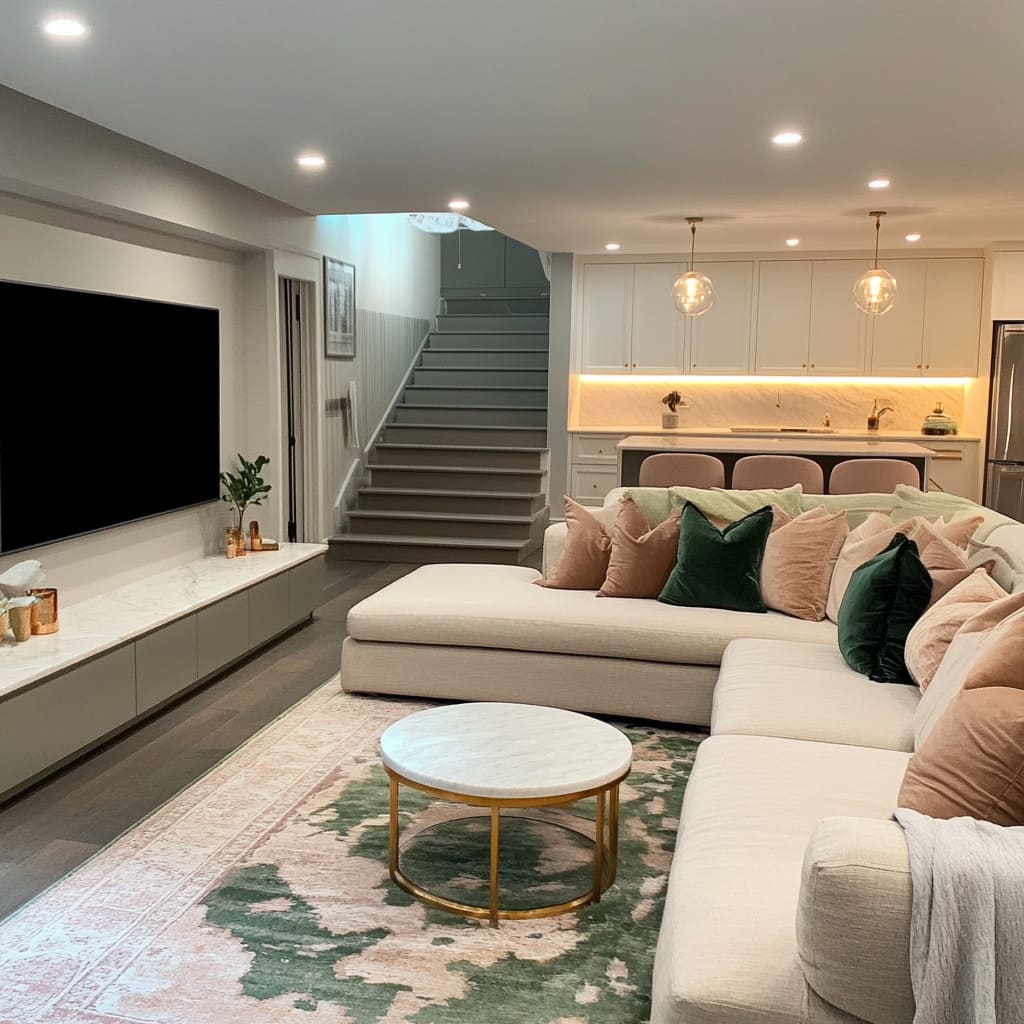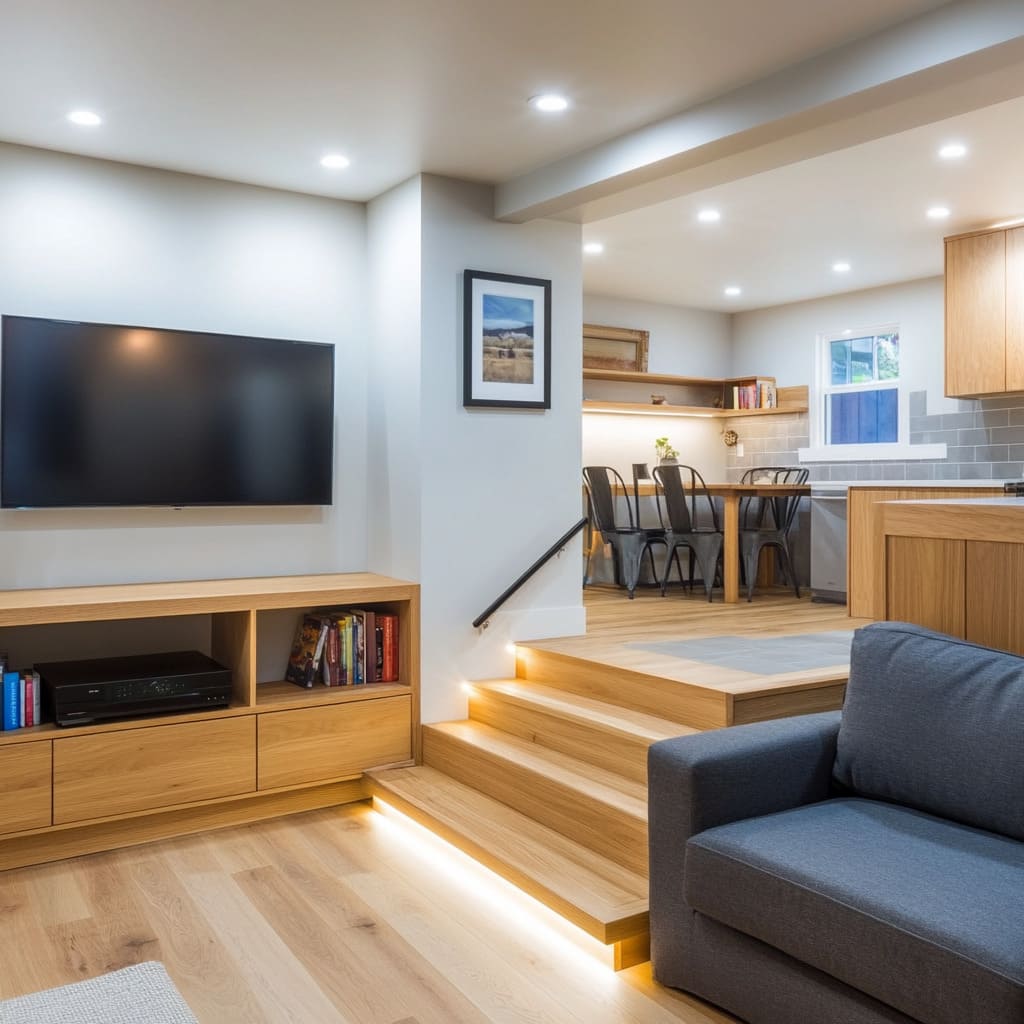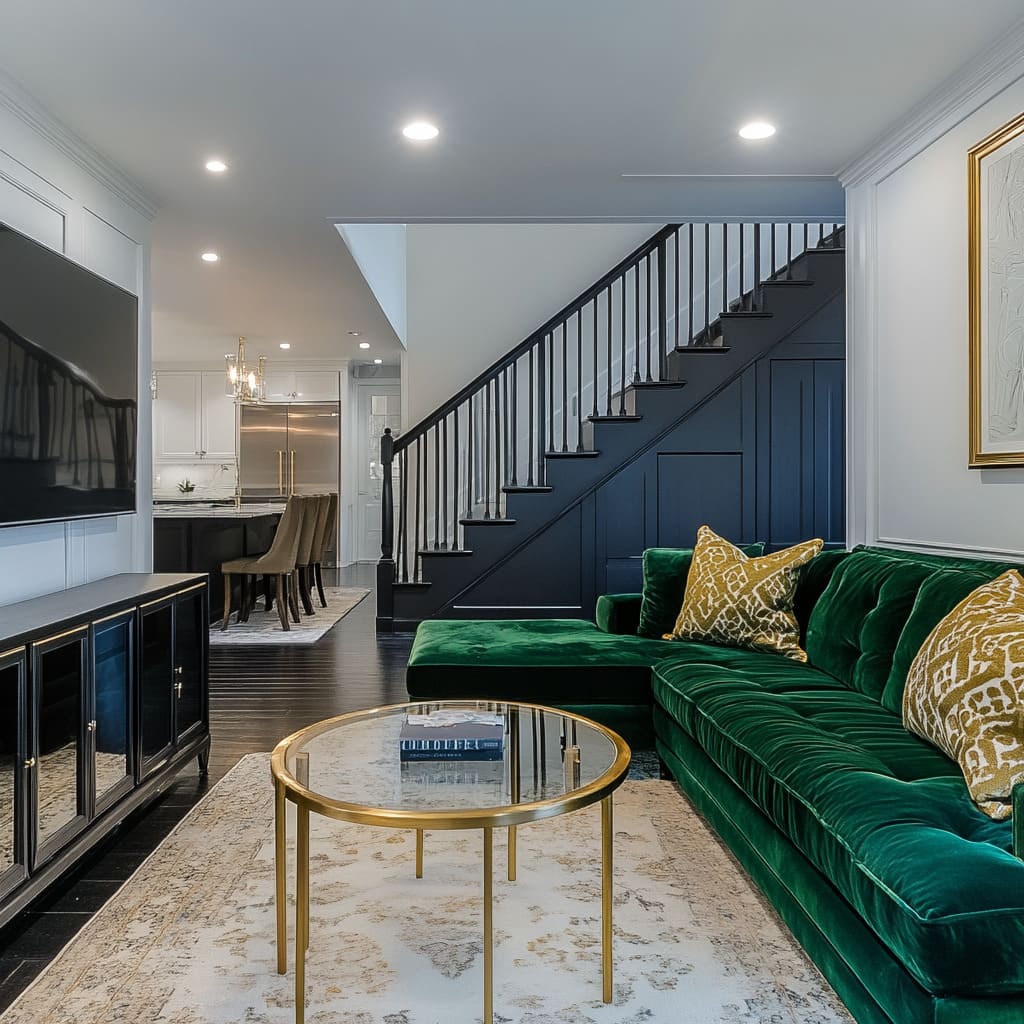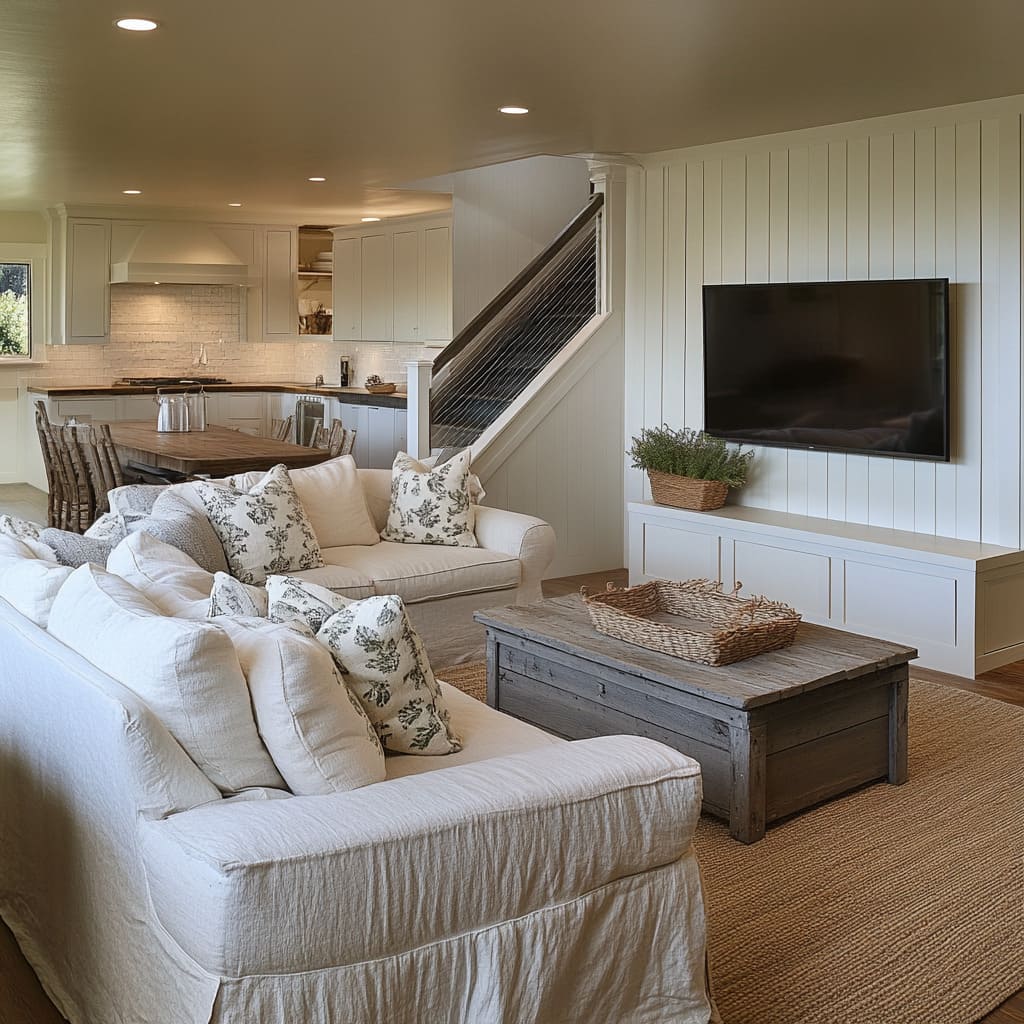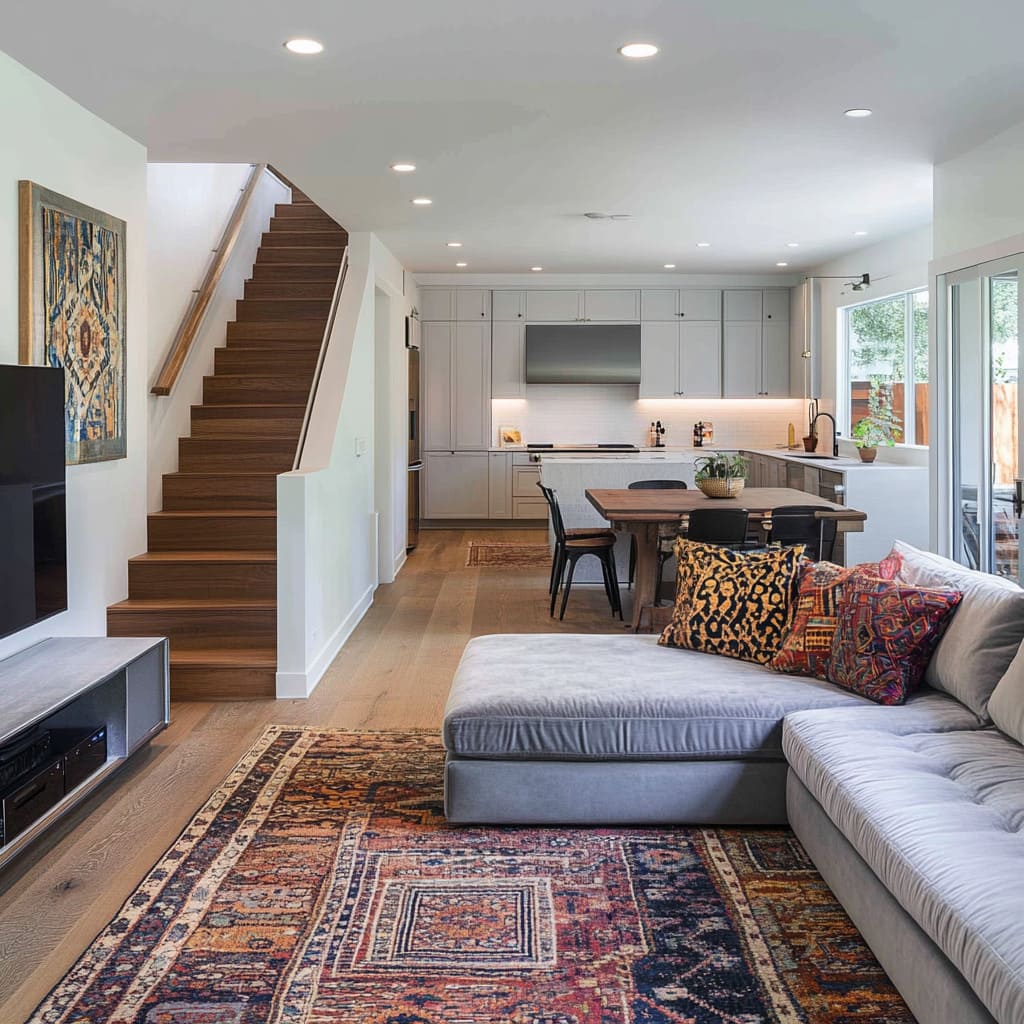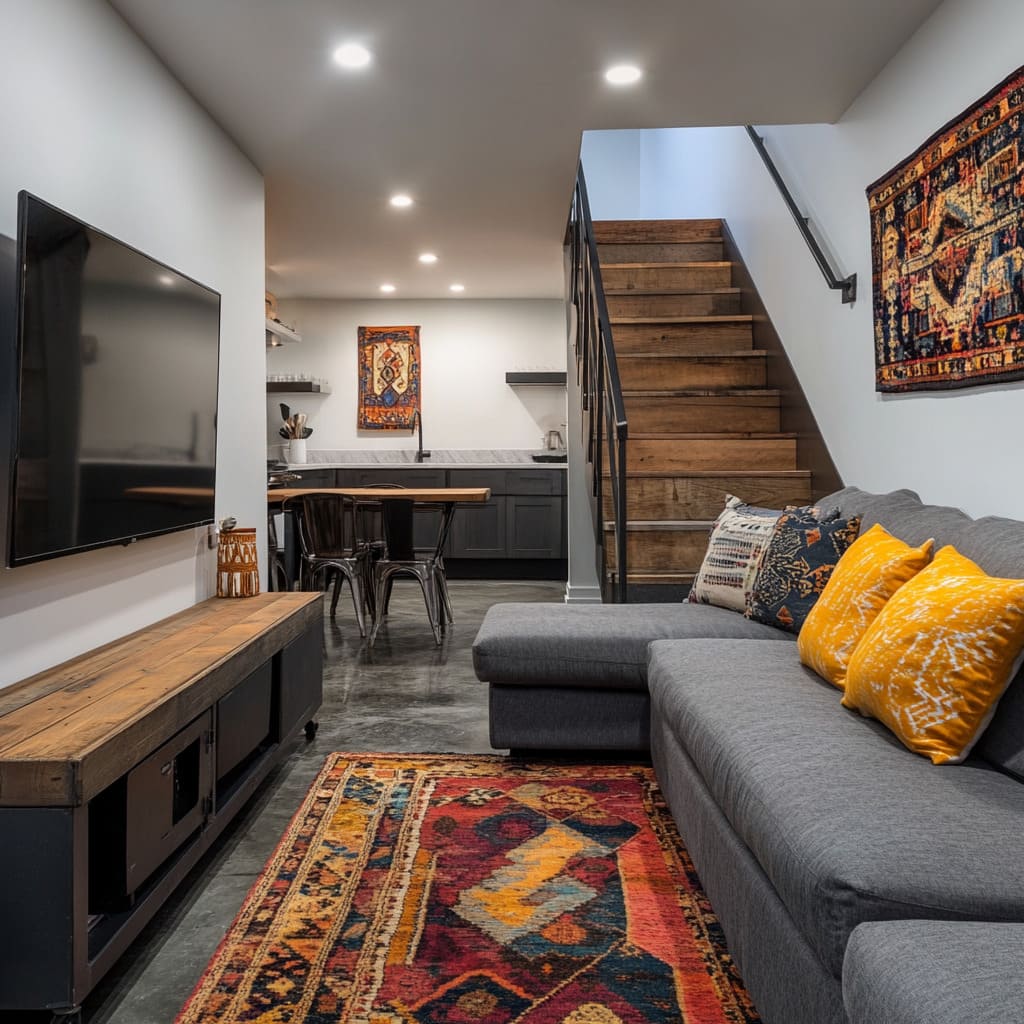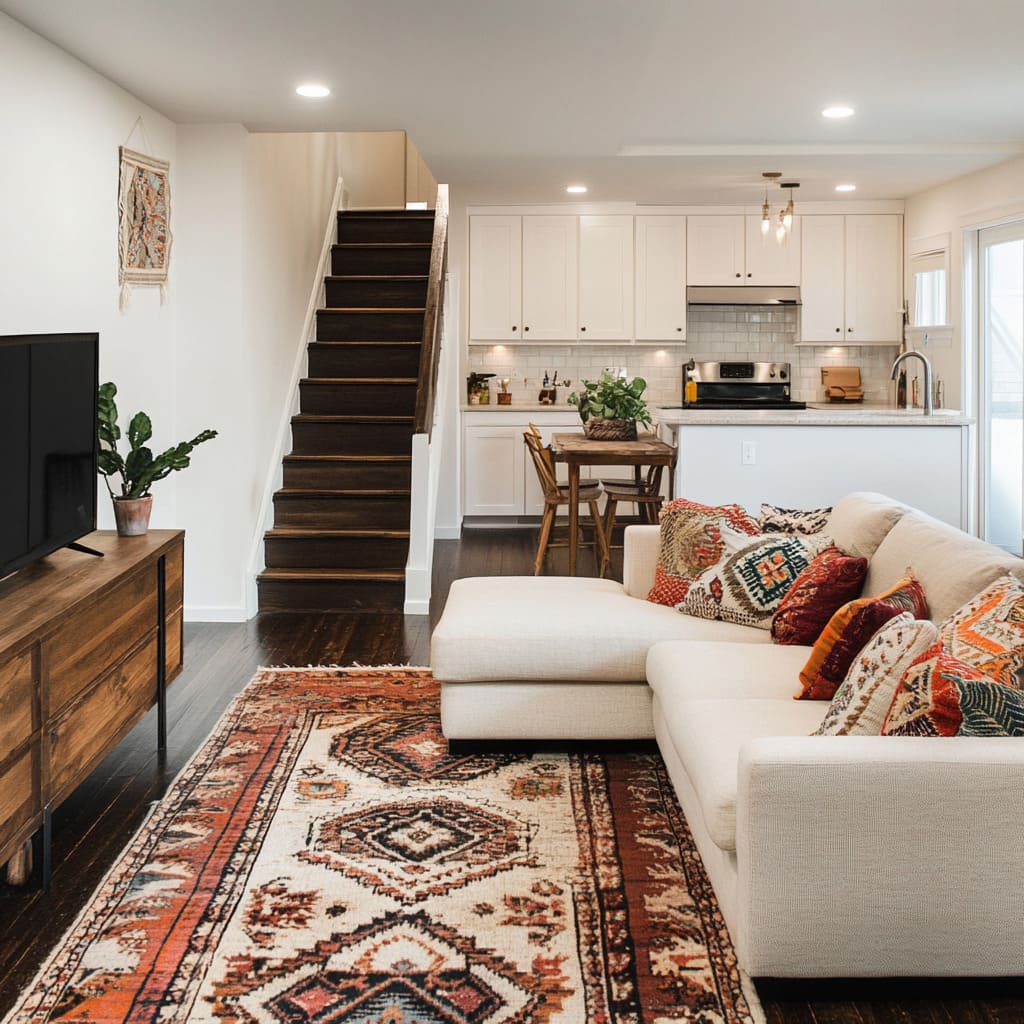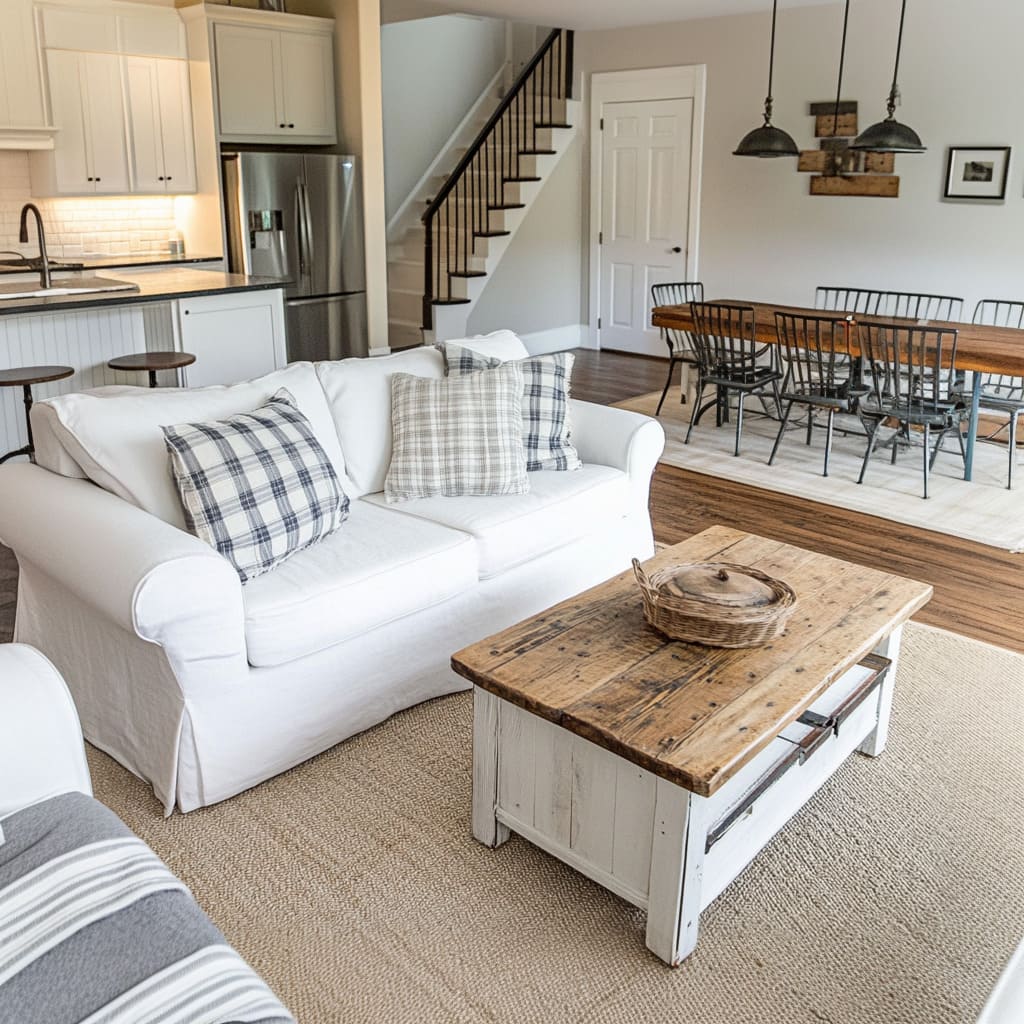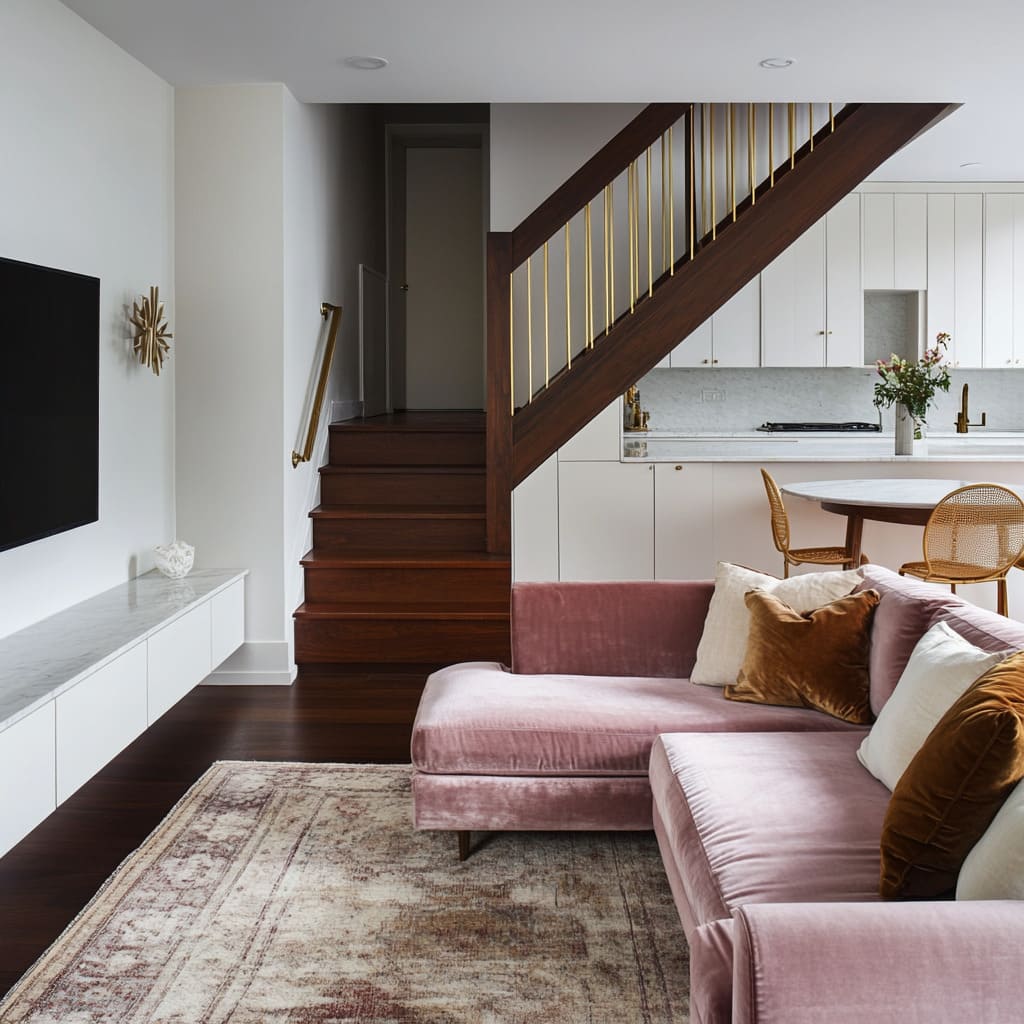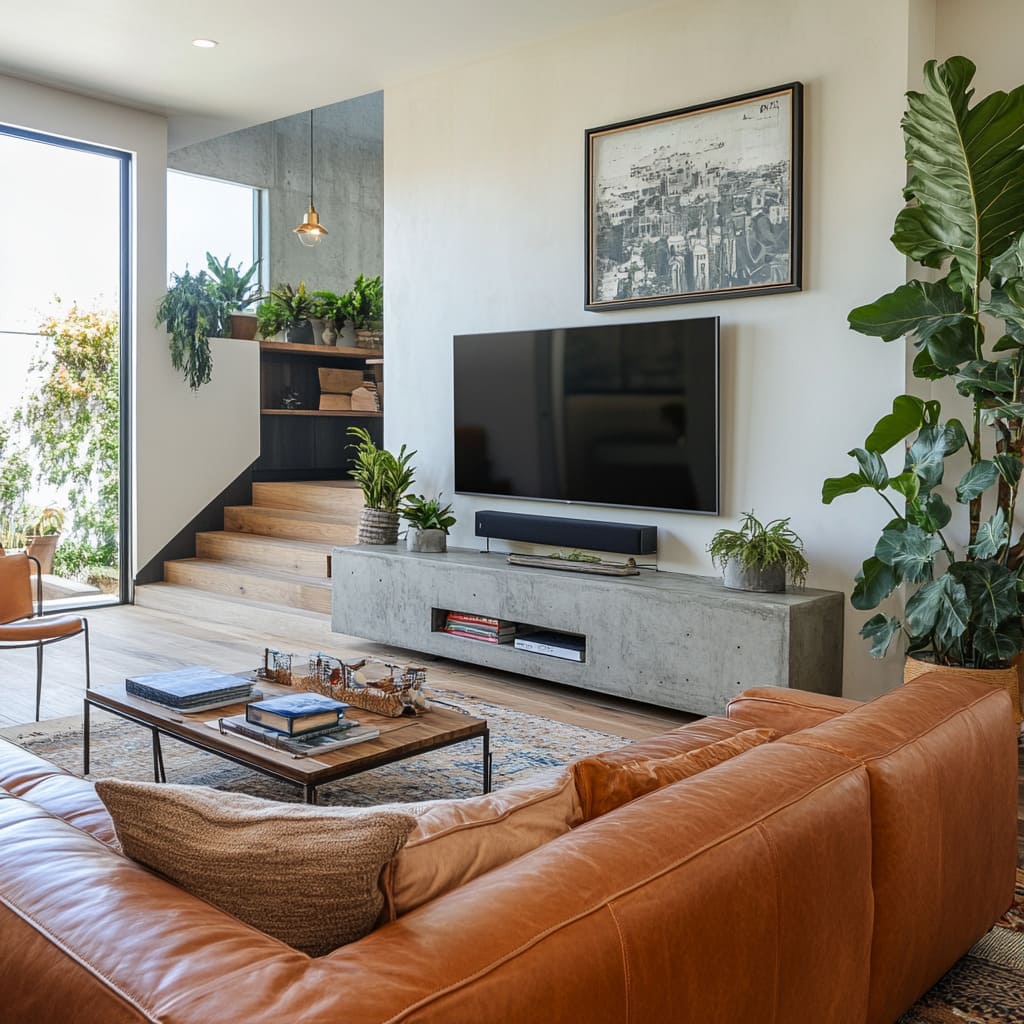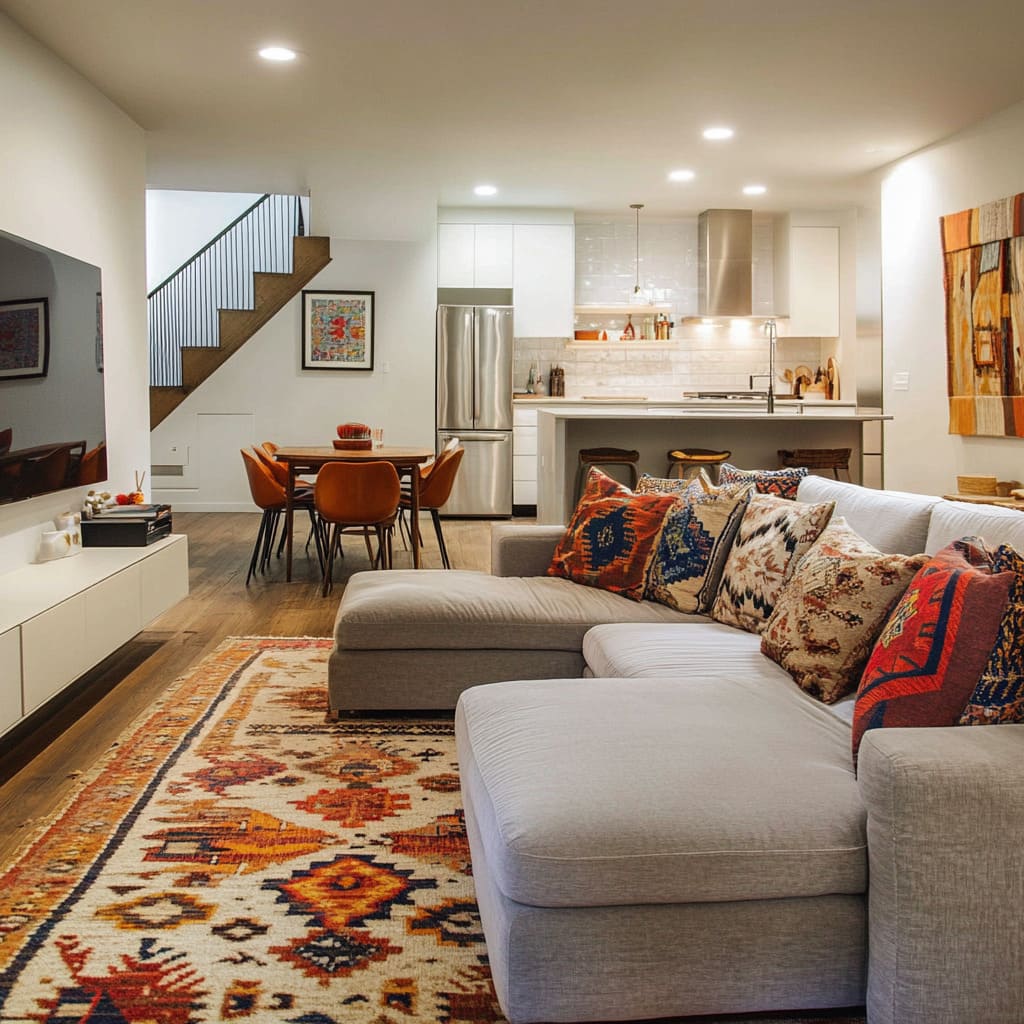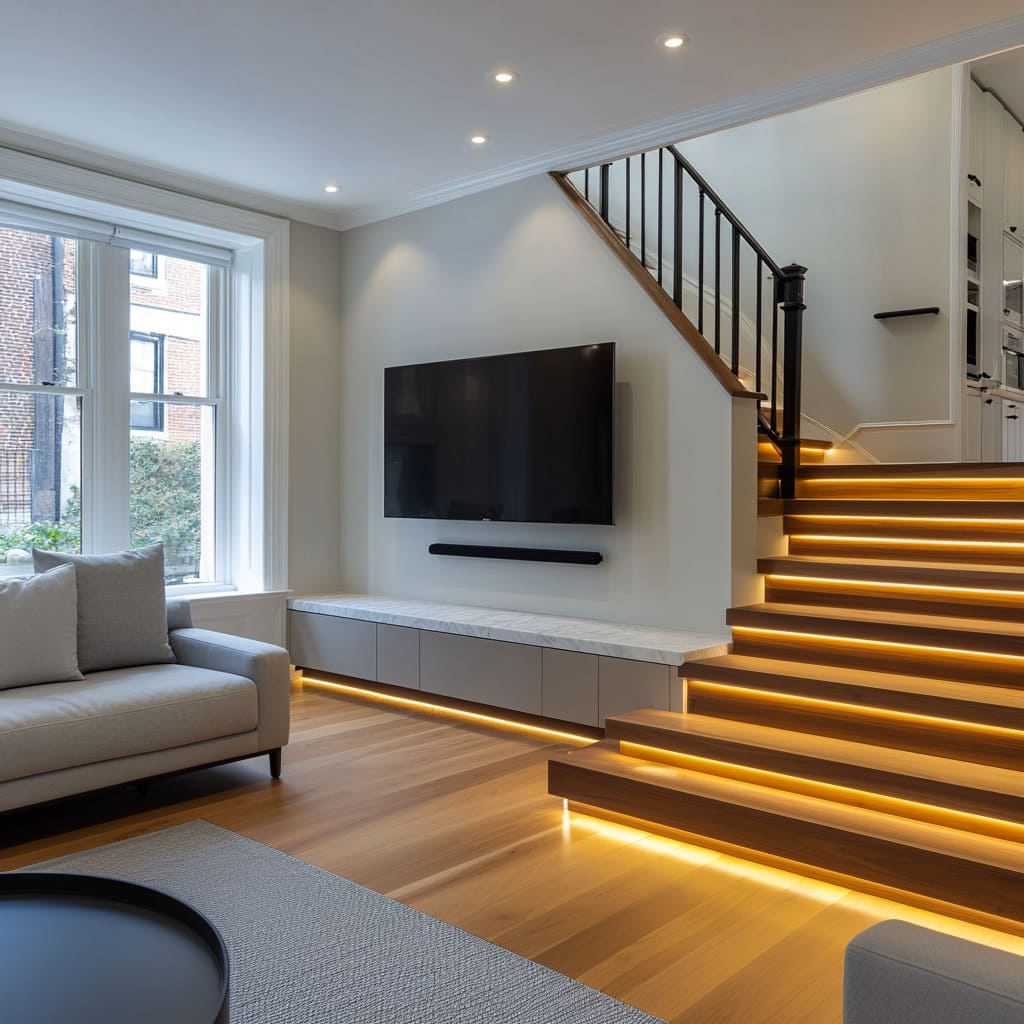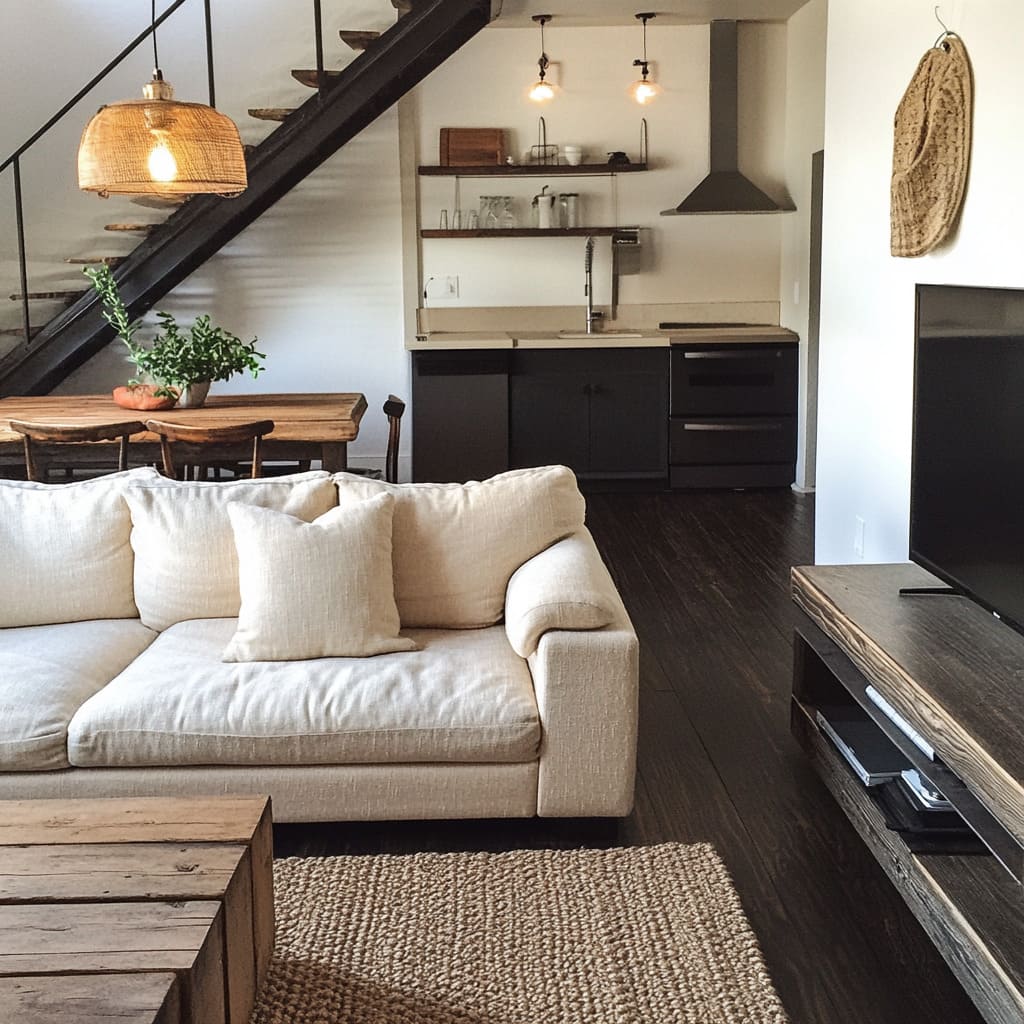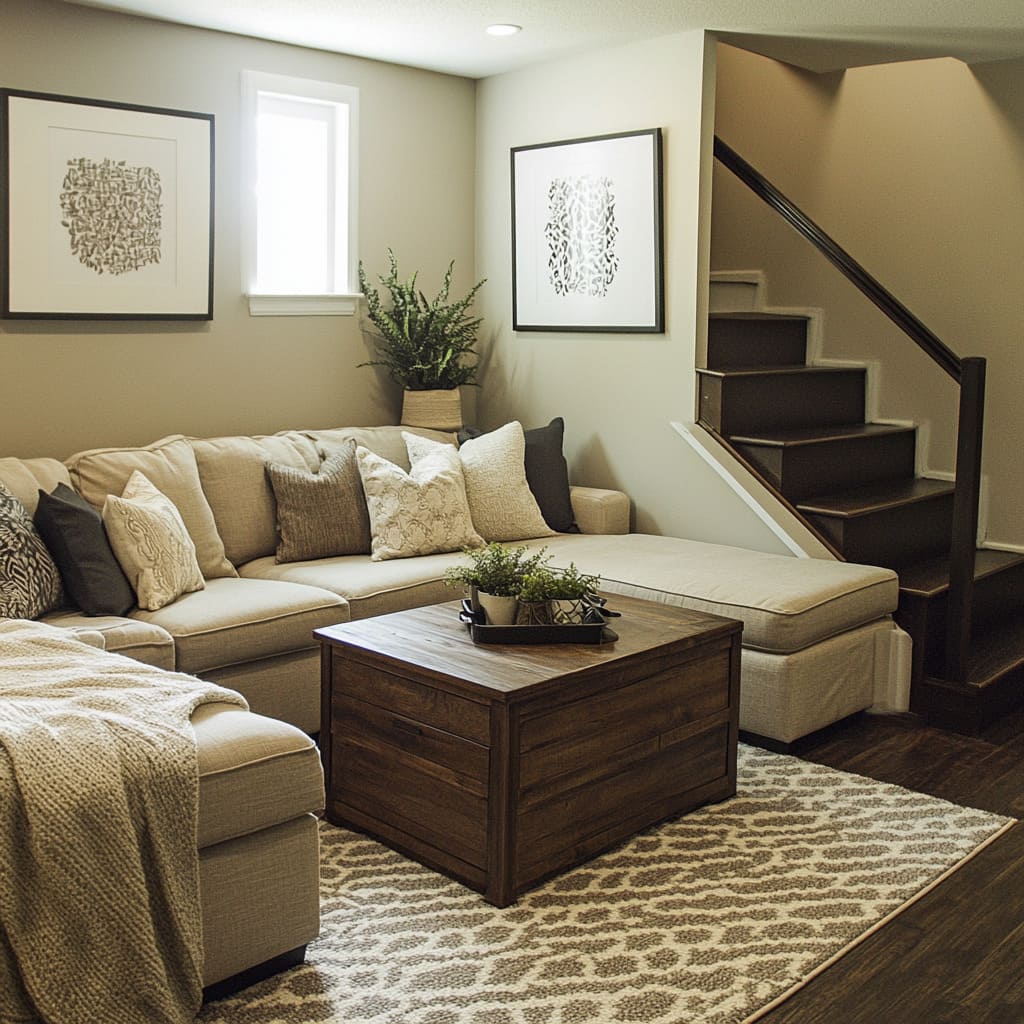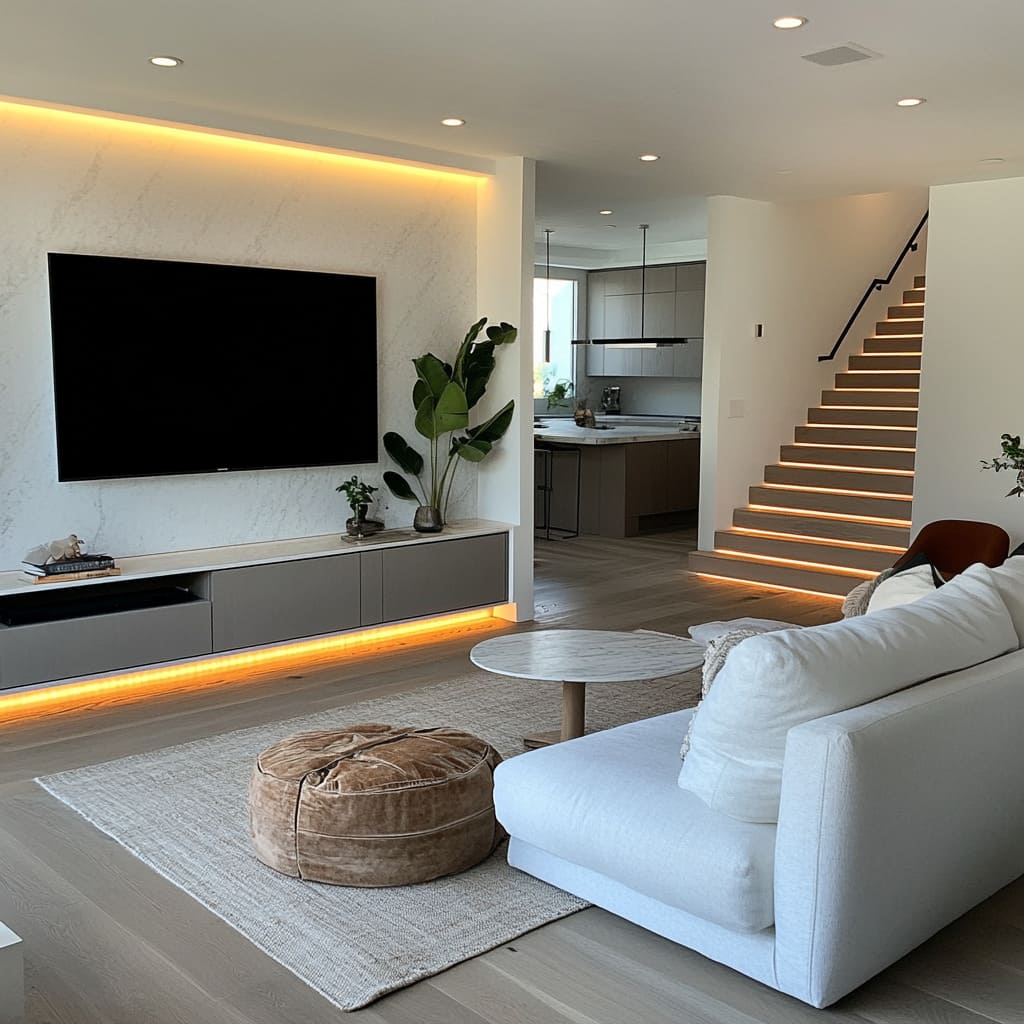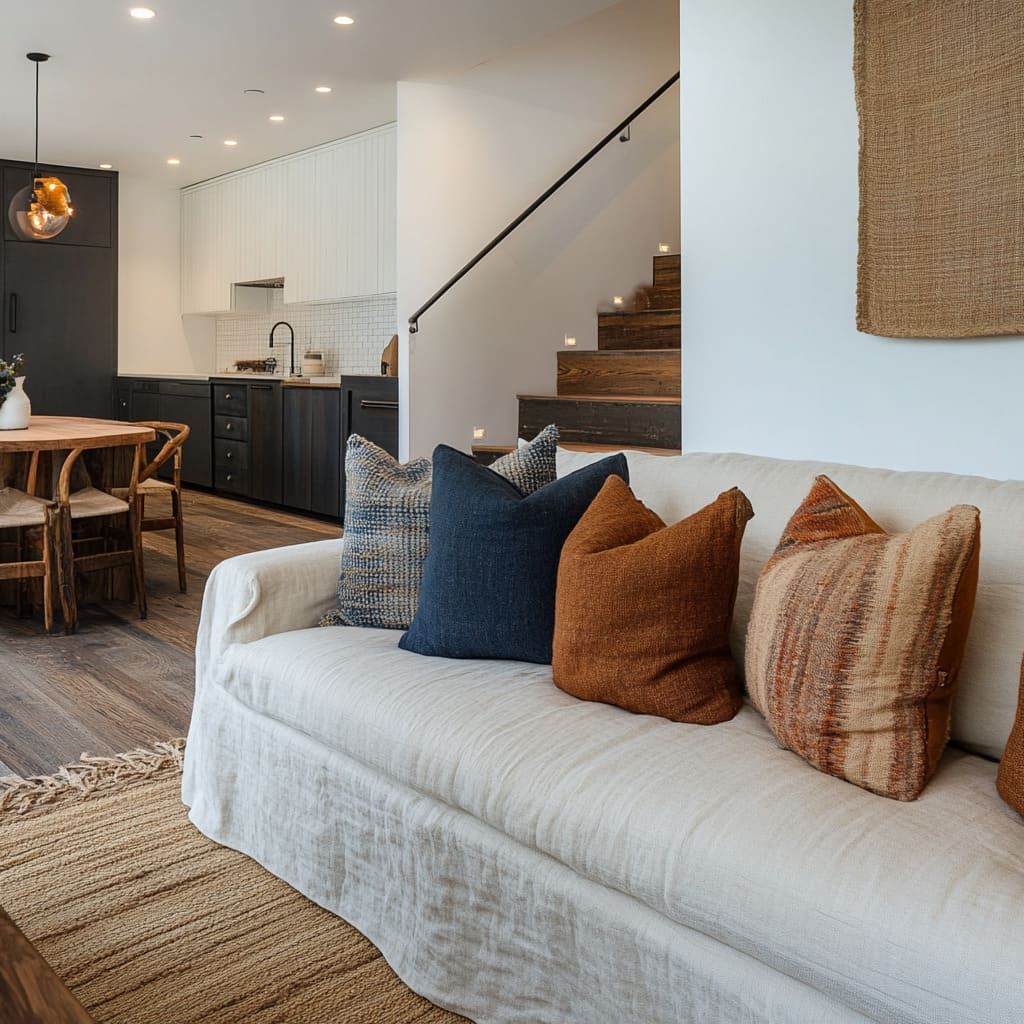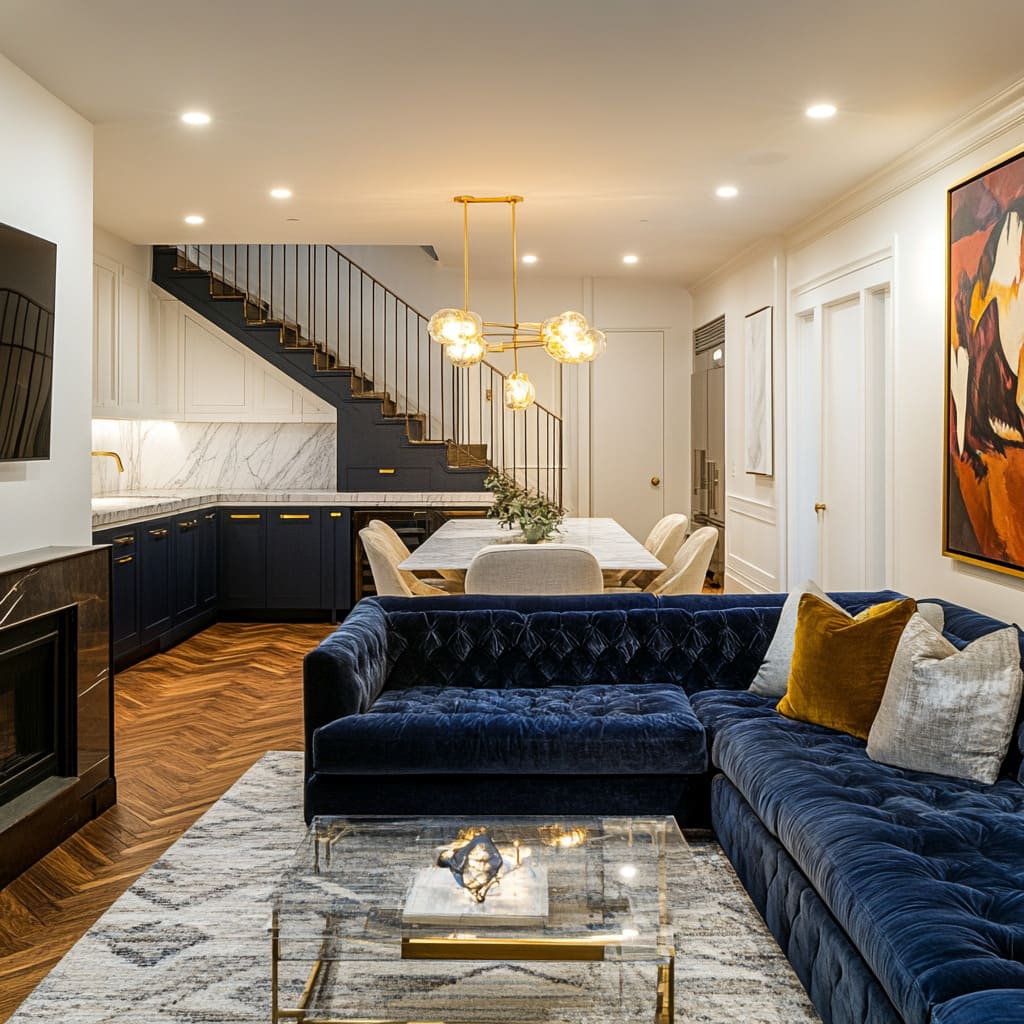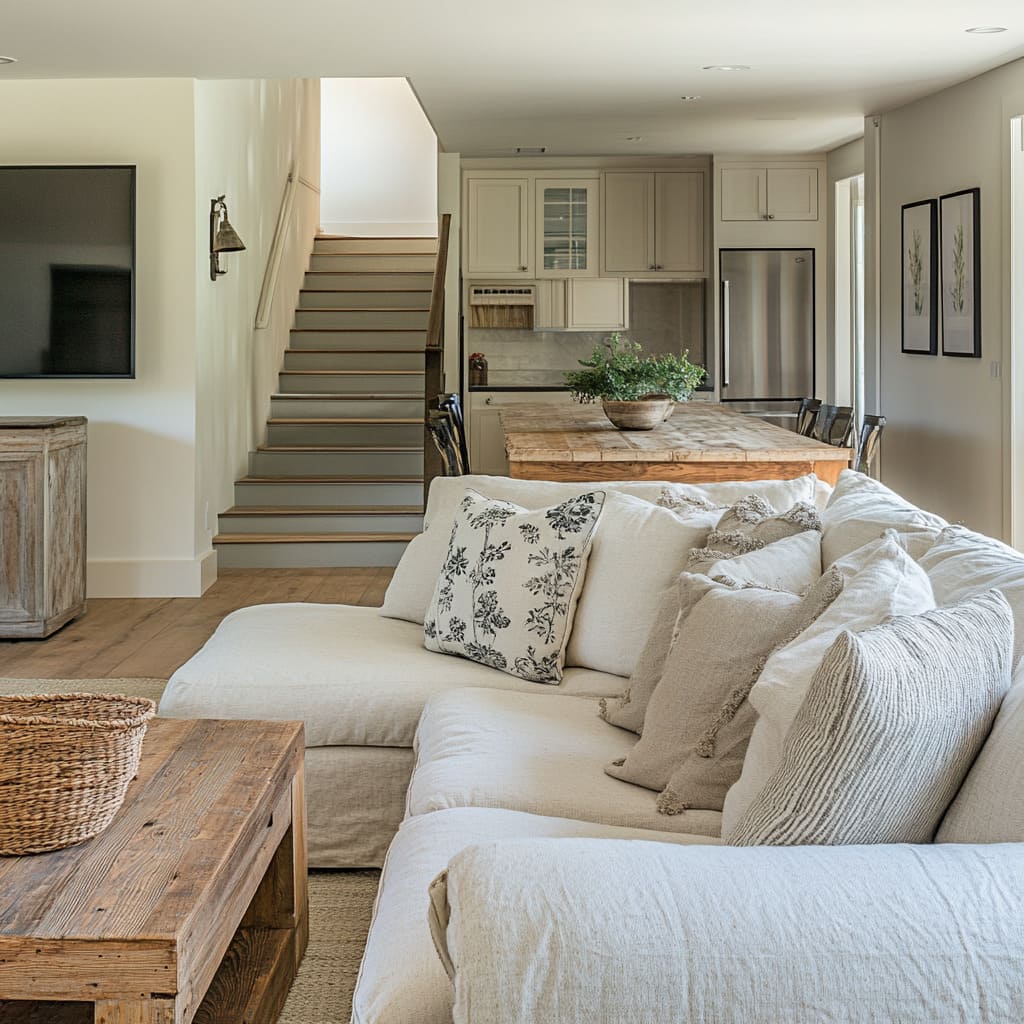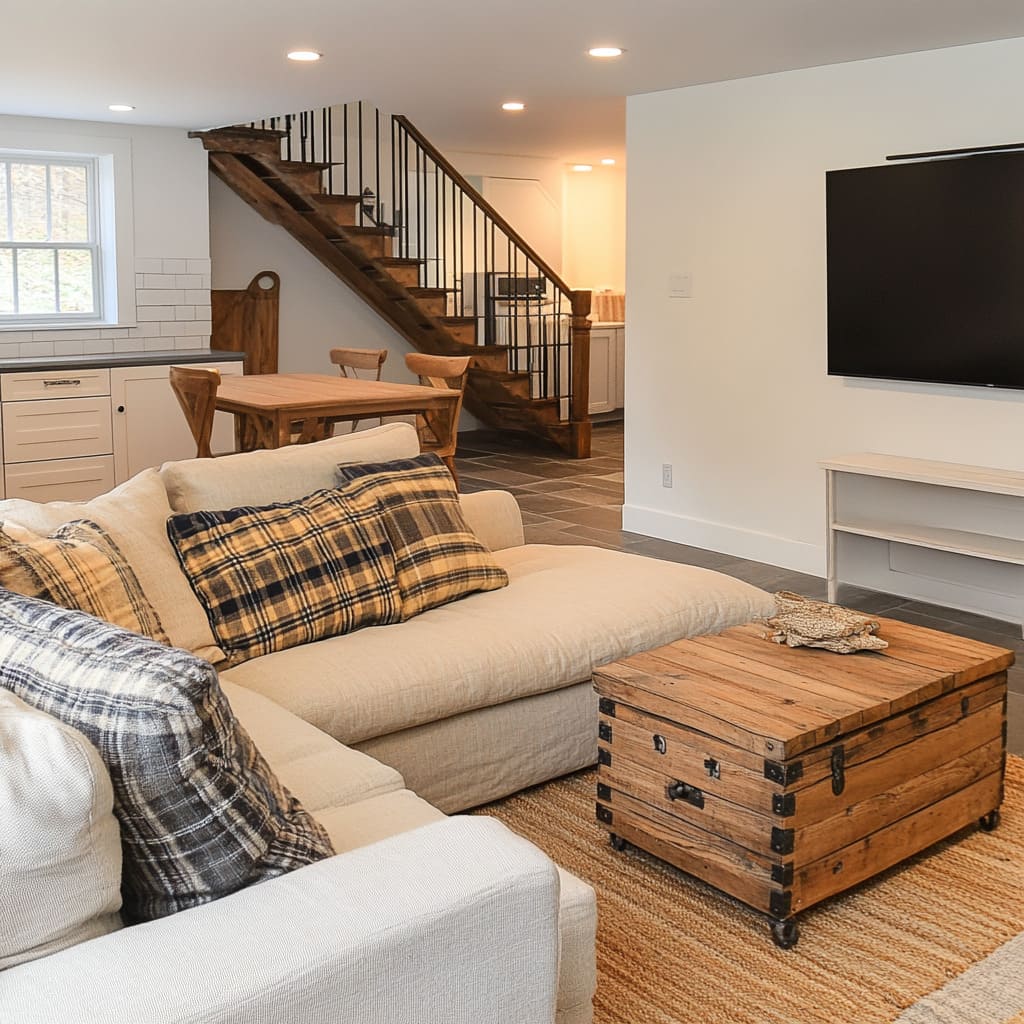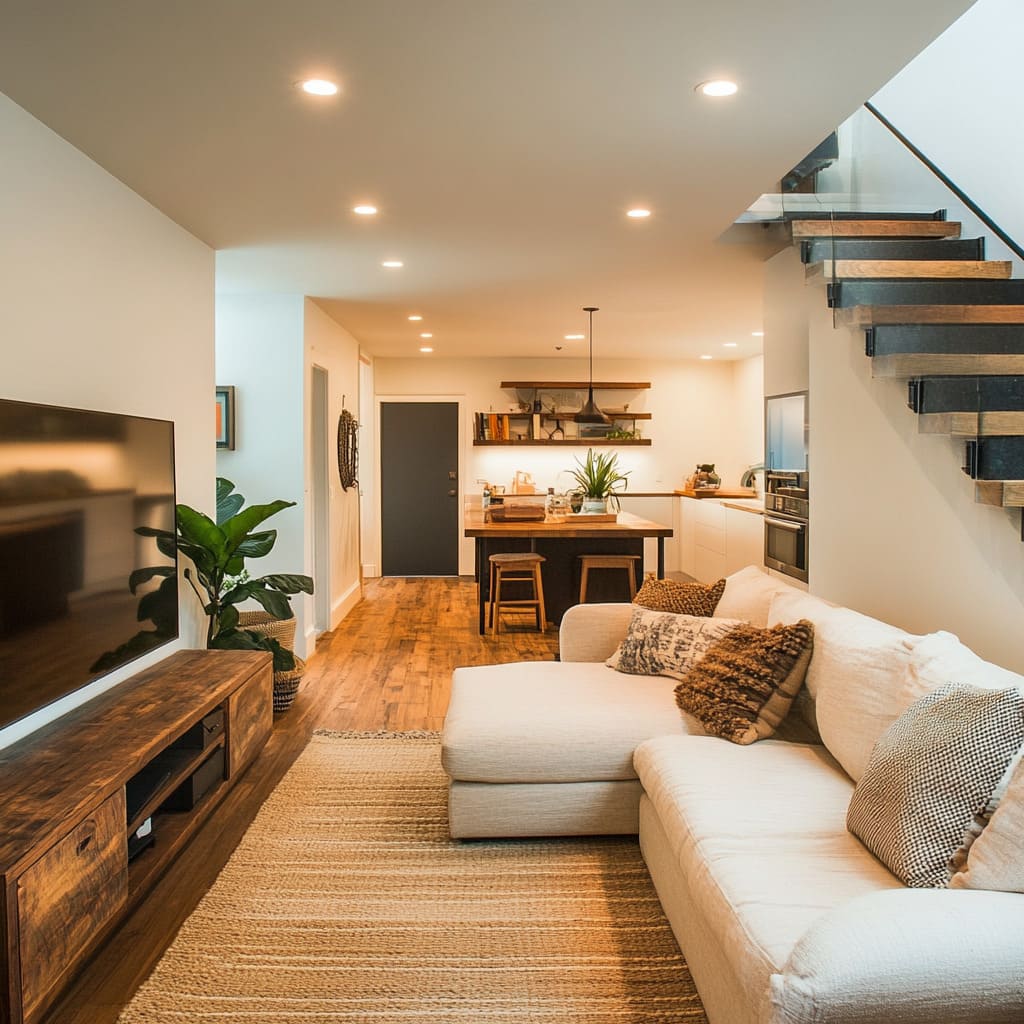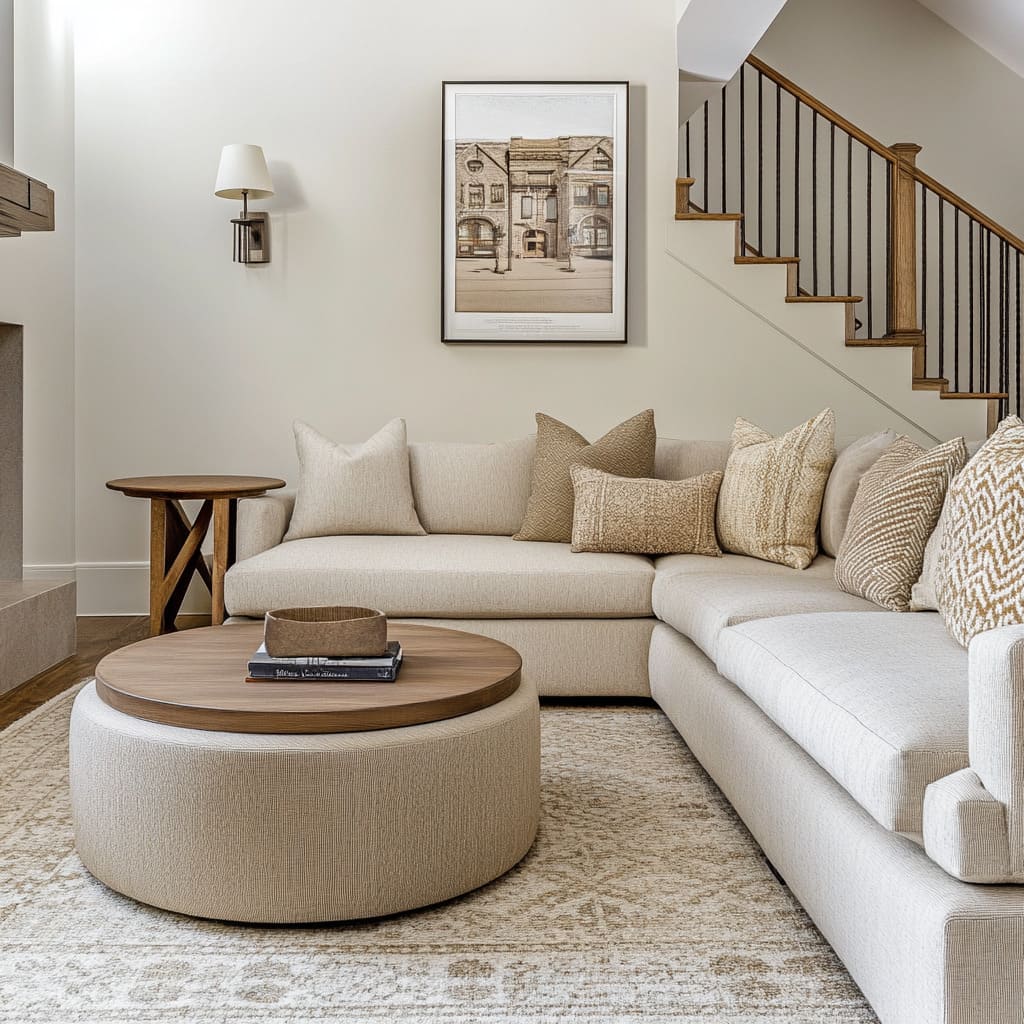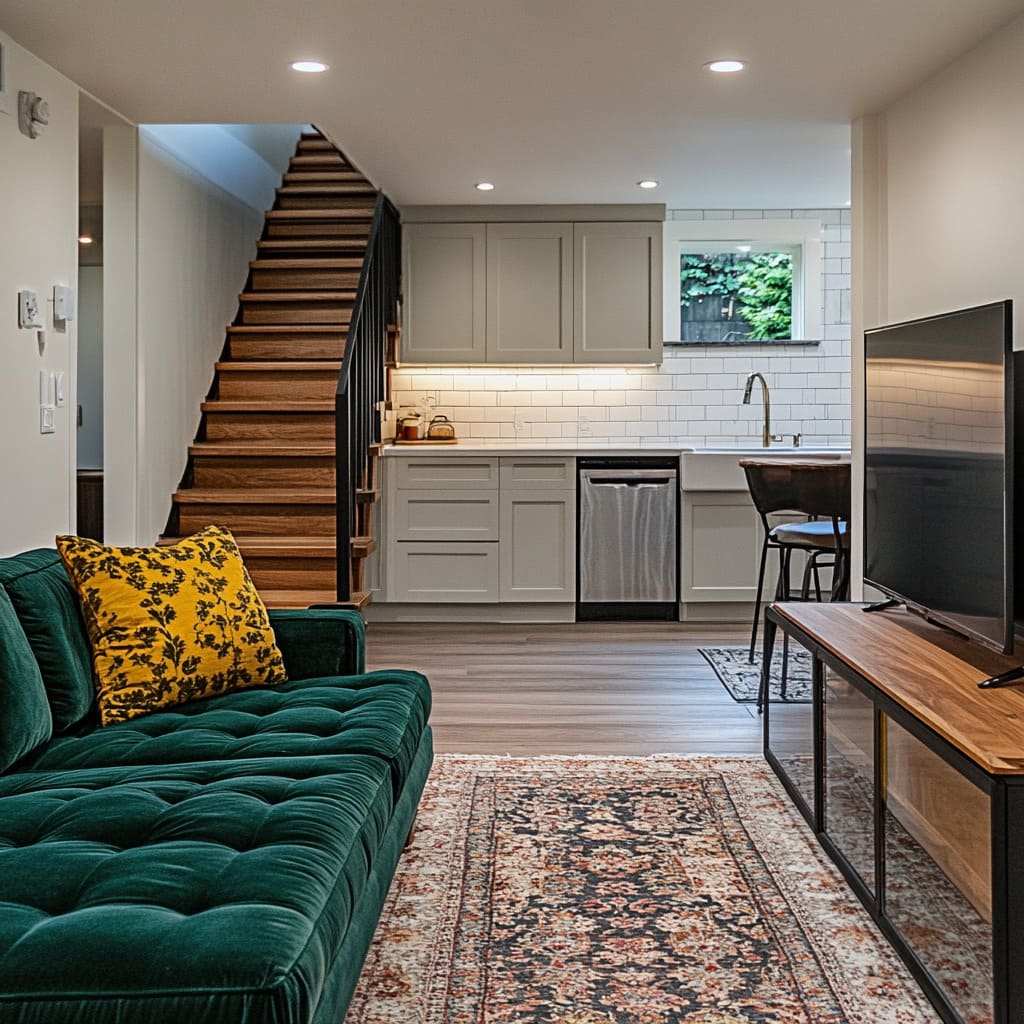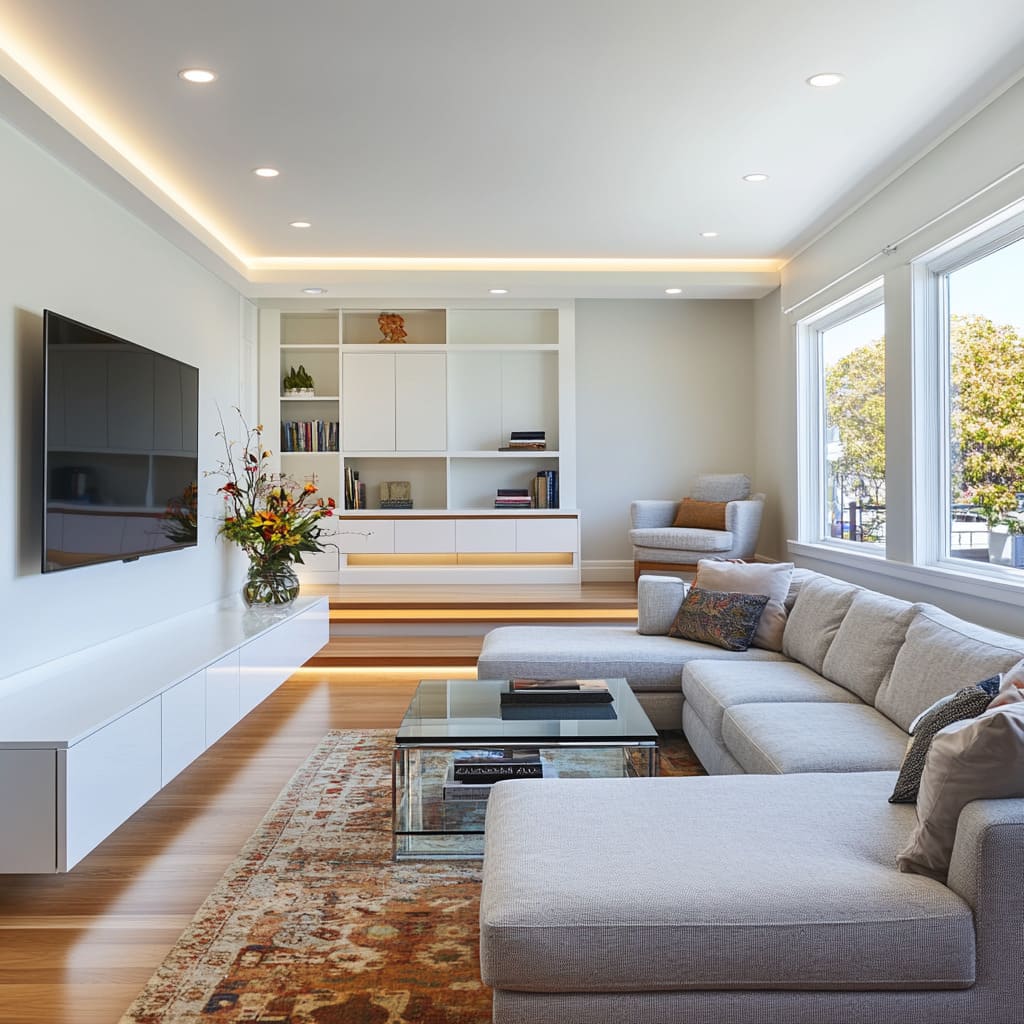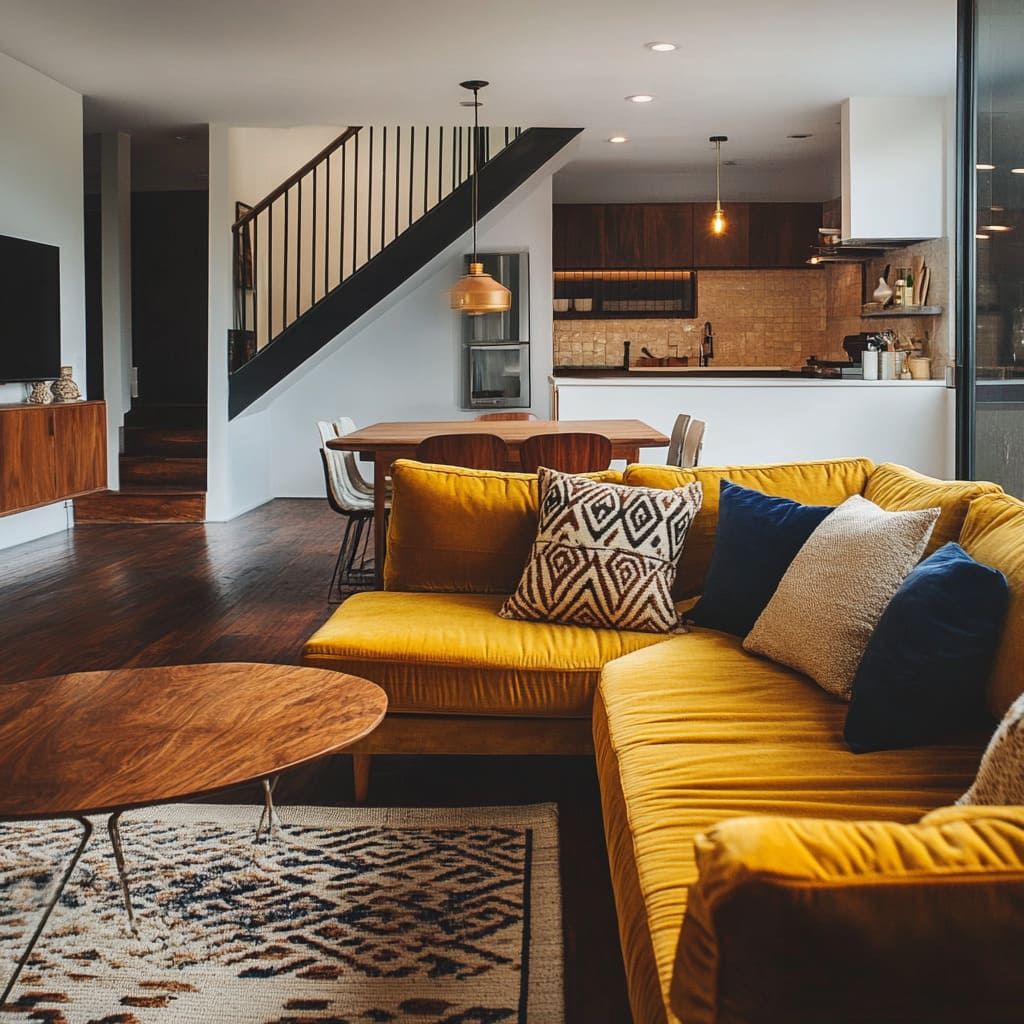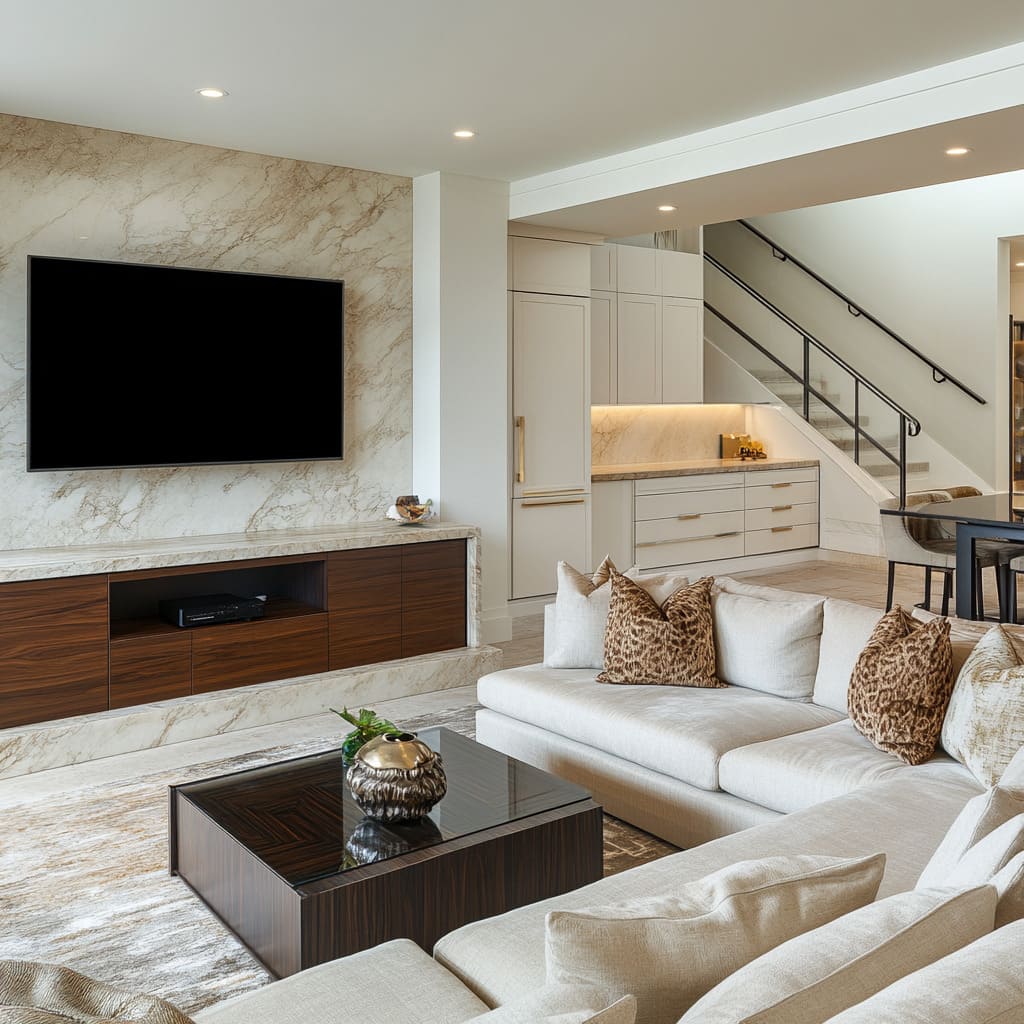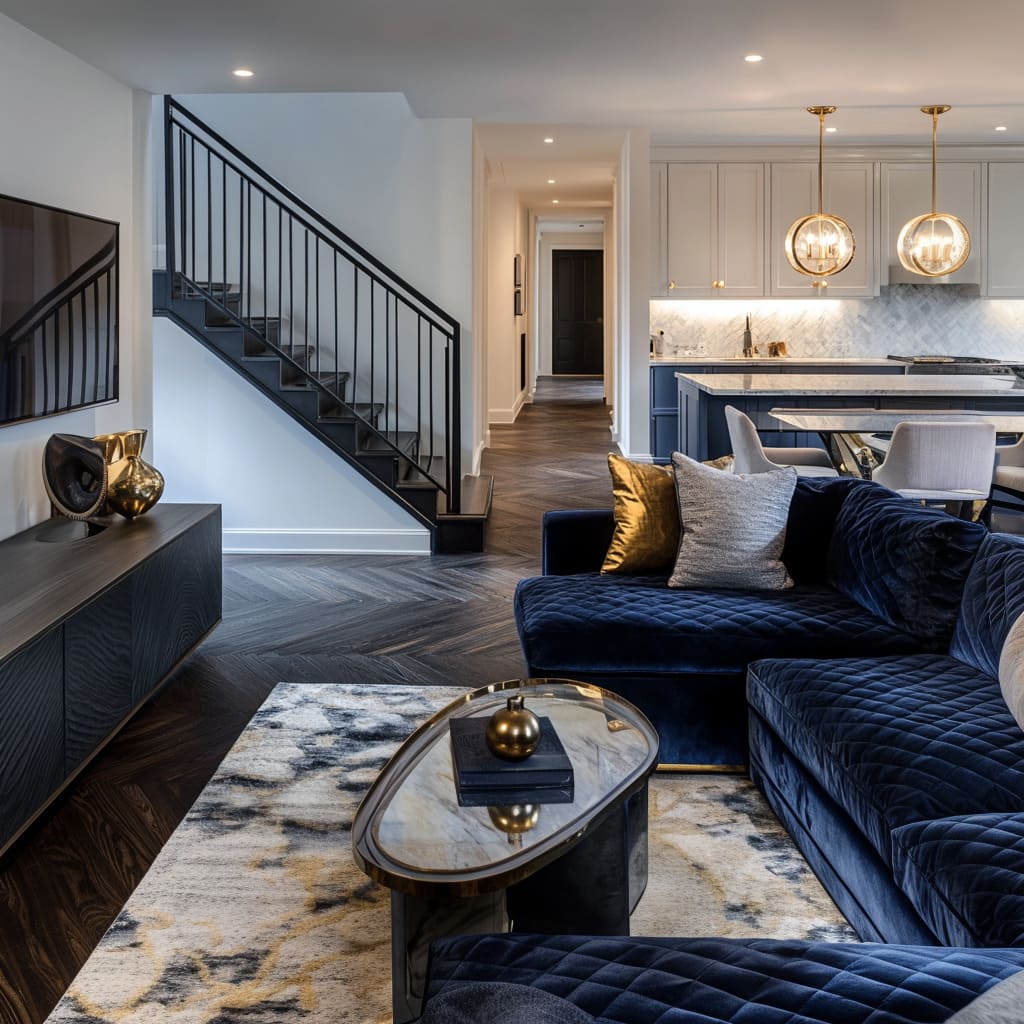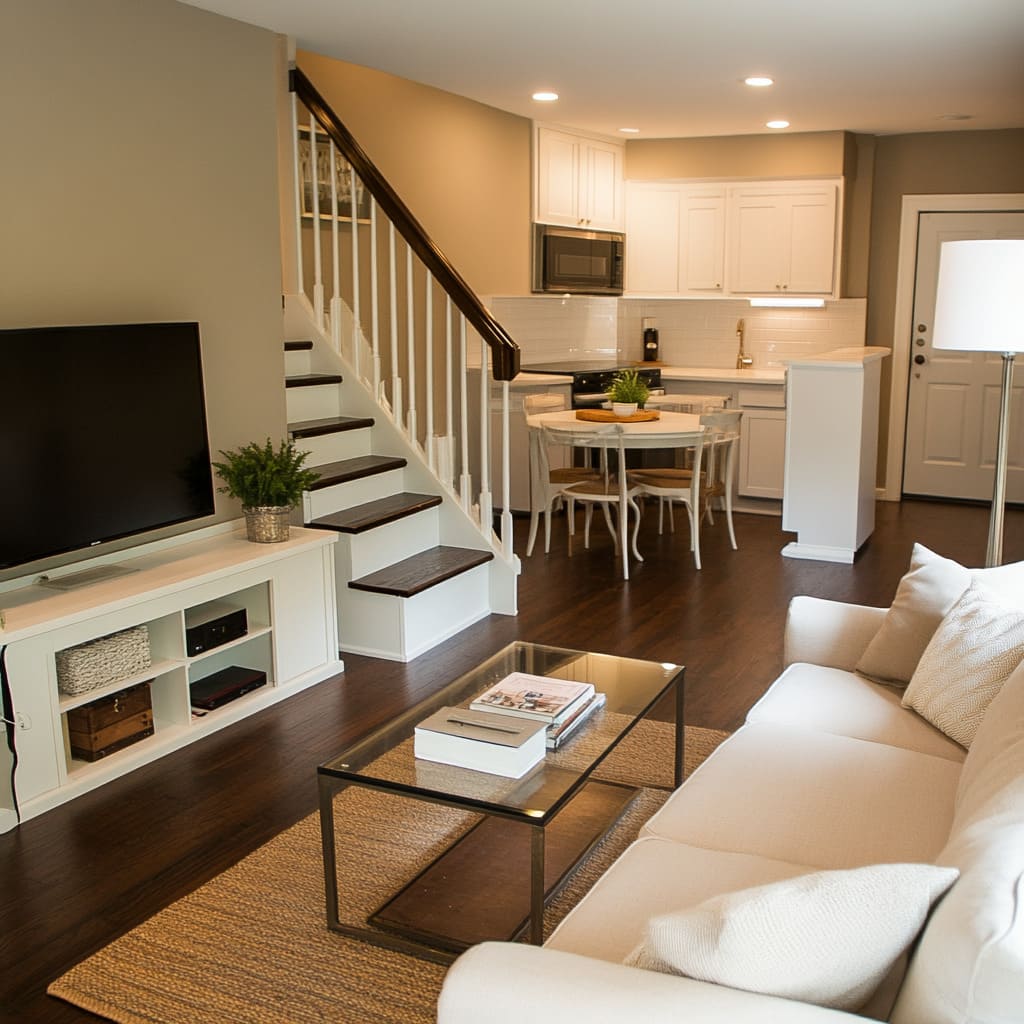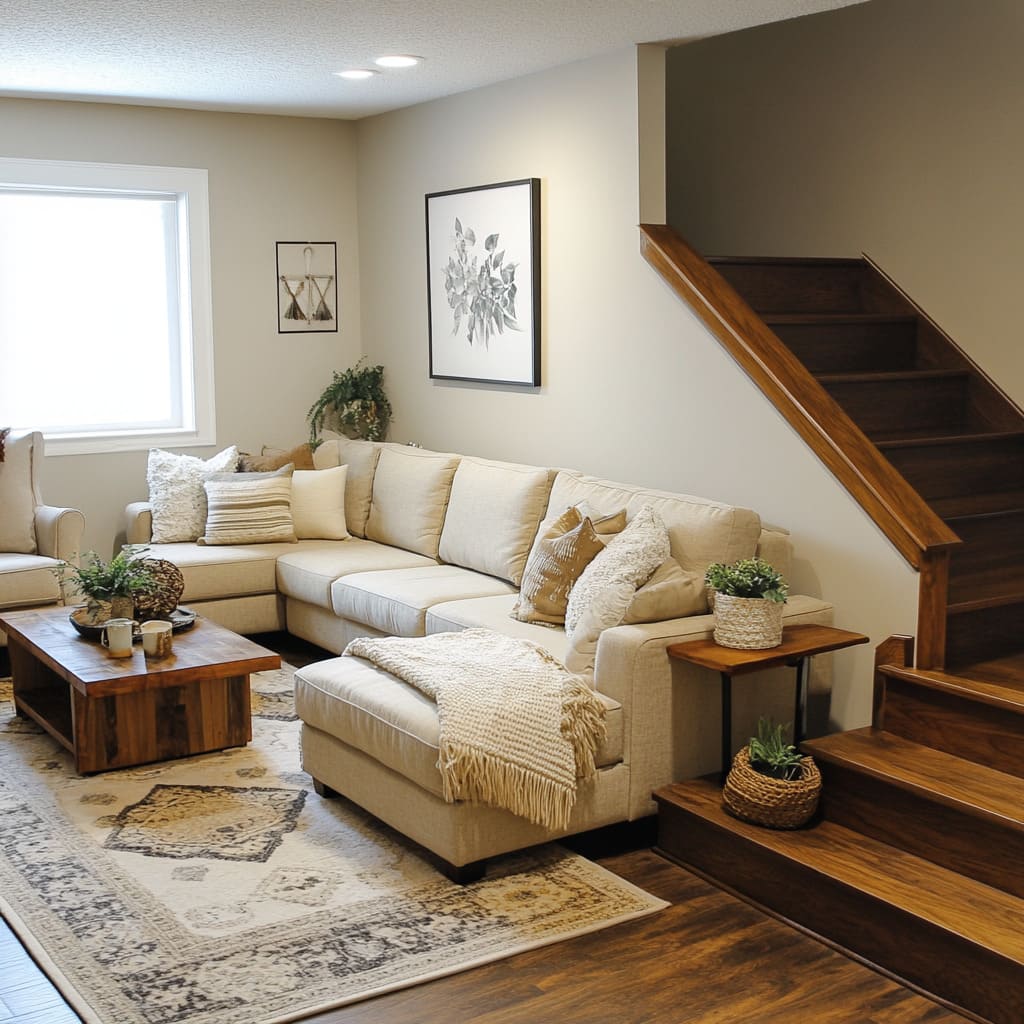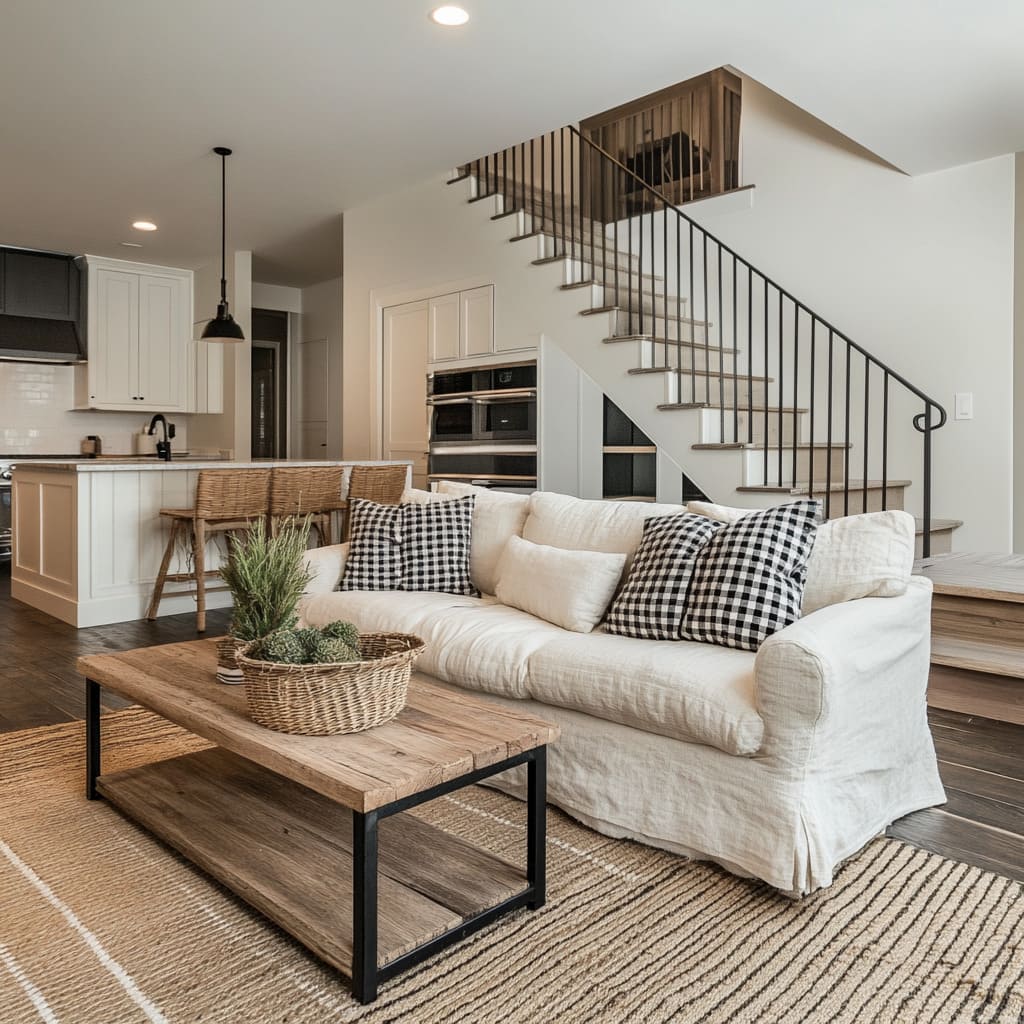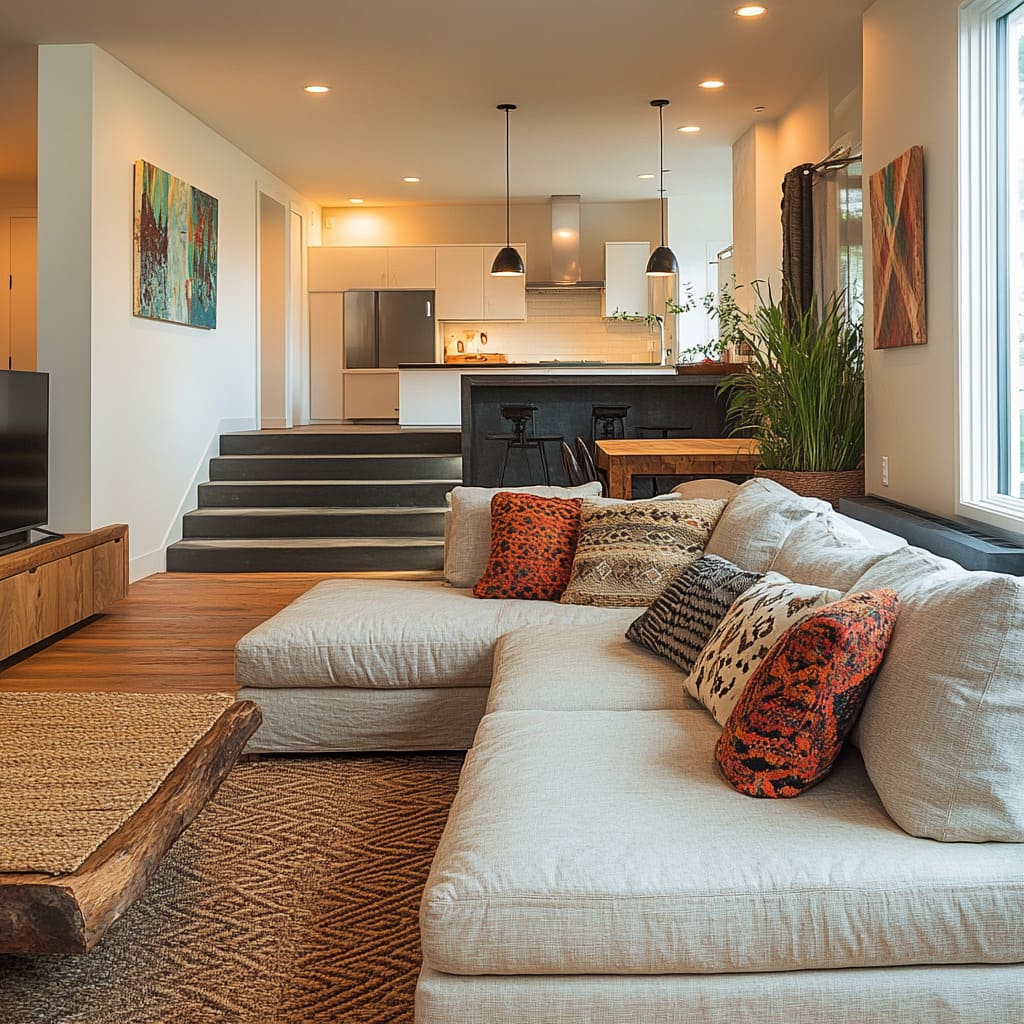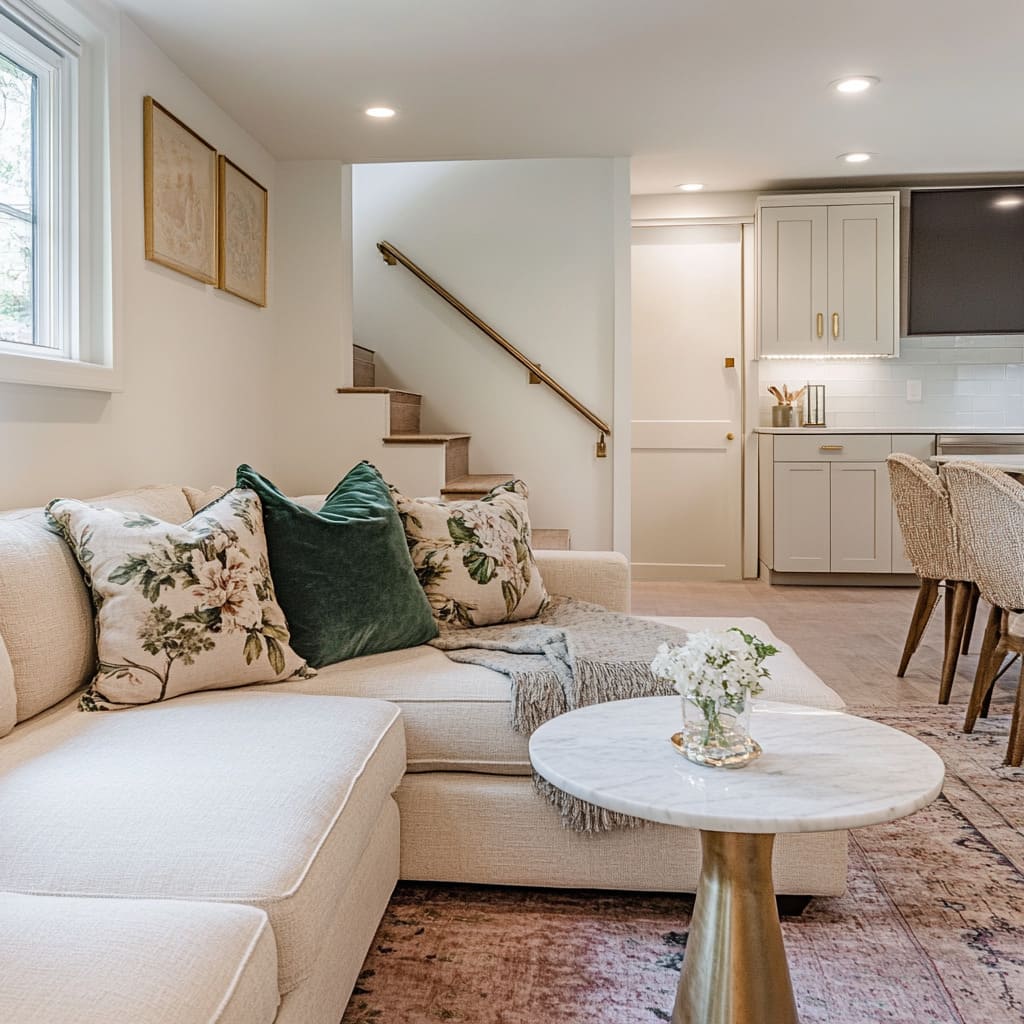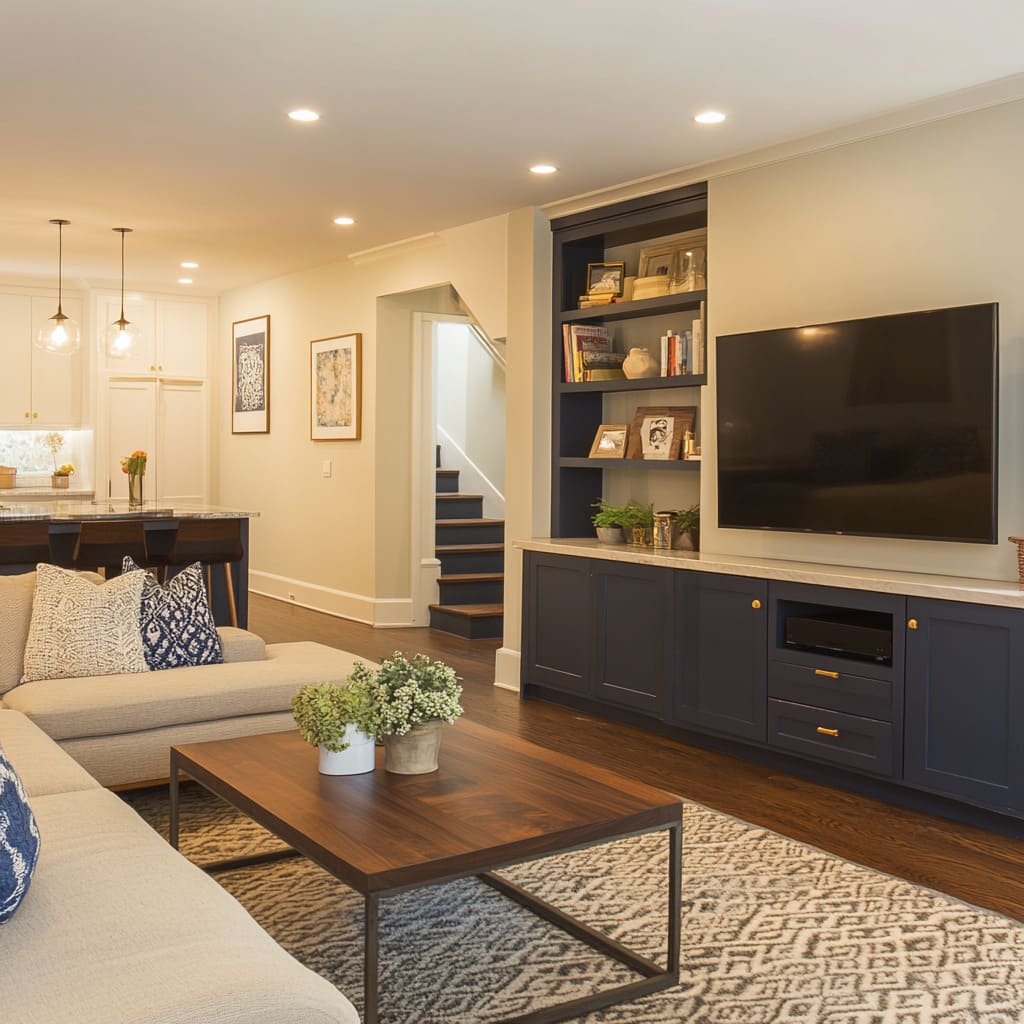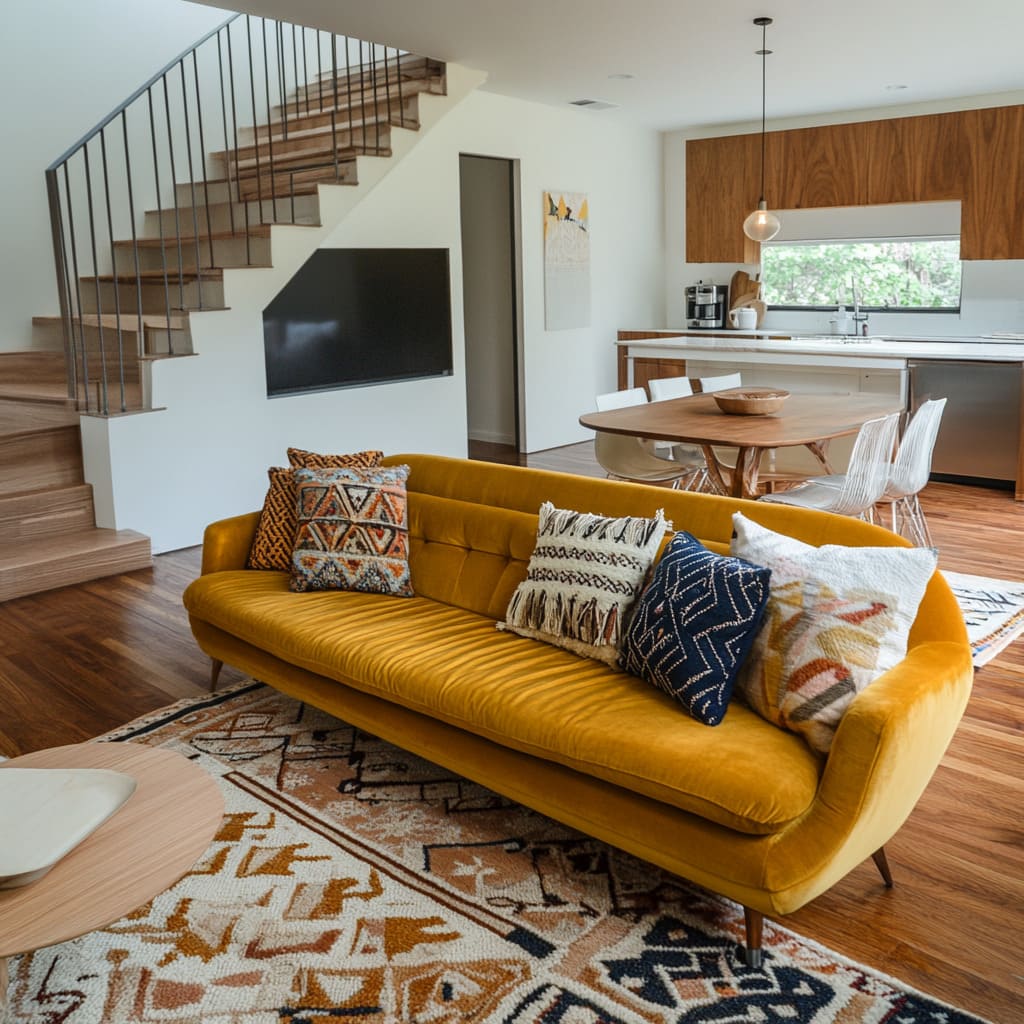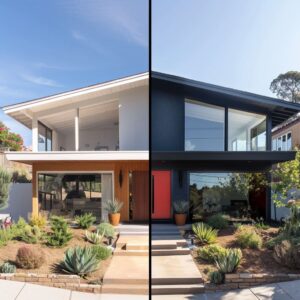A split-level living room presents a unique challenge in home design. With the different levels often creating distinct zones, it can sometimes be tricky to balance the sleek, modern design elements that many people love with the warmth and comfort that make a house feel like home.
While modern interiors often focus on clean lines, open space, and minimalism, it’s equally important to infuse a sense of coziness and warmth into the living space, especially in a small home. This is especially true for small living rooms in split-level homes, where every square foot needs to be carefully considered to avoid feeling cramped or disjointed
The purpose of this article is to explore practical, creative ideas that help homeowners achieve the perfect blend of modern and cozy. From smart layouts to the right color choices, we’ll cover the key design strategies that can transform a small split-level living room into a stylish and inviting retreat.
Whether you’re decorating from scratch or looking for ways to refresh your current space, these ideas will help you create a living room that balances form and function beautifully
The Power of an Open Layout
One of the key elements of making split-level living rooms feel inviting and spacious is maximizing the open layout. Small split-level homes often benefit from the absence of walls or heavy partitions, which allows for better flow between the different areas of the house.
In a small living room, maintaining an open layout is especially important for creating the illusion of more space and avoiding the feeling of being boxed in. An open layout also lets natural light move freely through the home, enhancing the overall atmosphere.
When there are no barriers between the living room, kitchen, and dining areas, light can travel through the entire space, making it feel larger and brighter. This is particularly useful for homes with limited square footage, where light and openness can make a big difference
To make the most of the open layout, strategic zoning becomes important. By arranging living room furniture for small living rooms thoughtfully, you can subtly define different areas without disrupting the flow.
For example, a well-placed sectional sofa can act as a divider between the living room and kitchen or dining area, helping to create a sense of separation while maintaining the overall cohesiveness of the space. The furniture itself can define zones, ensuring that each area feels distinct but still connected
Neutral Color Palettes for Calm
When it comes to modern design, neutral color palettes are a reliable foundation. Soft tones like beige, cream, light grey, and white are perfect for small living room decorating ideas because they help to visually open up the space.
These lighter colors reflect natural light, giving the room an airy and fresh feel. They also serve as a backdrop that allows you to layer in other elements of texture and color without overwhelming the eye.
In small living rooms, using neutral tones helps keep the space from feeling too busy or cluttered. Instead, it allows the eye to focus on the room’s overall design and flow.
The key to ensuring that a neutral palette doesn’t feel too plain is by layering different textures throughout the room. Soft throw pillows, a textured area rug, or even fabric-upholstered chairs can add the needed depth and interest to a neutral base, creating a welcoming and comfortable atmosphere
For example, pairing a soft beige sofa with textured cushions and a woven area rug is a great way to make a space feel more inviting. The use of layered textures avoids the risk of the room looking too flat or sterile, making it feel balanced and warm.
This is particularly helpful when you’re looking for small living room ideas with a TV, where the focus can often become too tech-centric. Soft textures and neutral tones help to make the space feel homely, even when modern technology is part of the room’s core function
Bold Accent Pieces to Add Personality
Adding personality to a living room doesn’t mean you have to overhaul the entire design. Often, it’s the smallest touches that have the biggest impact, and bold accent pieces are the perfect way to inject color and character into your space without overwhelming it.
For those looking to enhance the modern aesthetic of their living room with kitchen design for small spaces, carefully chosen bold elements can elevate the room from simple and functional to stylish and memorable
Introducing Color without Overpowering
Bold accent colors, when used thoughtfully, can completely transform a space. Imagine a sleek, neutral-toned room with clean lines suddenly brought to life by the introduction of a mustard-yellow sofa or vibrant throw pillows.
These pops of color instantly inject personality and vibrancy, making the room feel dynamic. The key is balance—while bold, these accent colors should never feel out of place or overpower the rest of the room’s design.
In a small living room, where space is limited, bright accents like jewel-toned pillows, an eye-catching area rug, or even a daring piece of art can draw attention and become a focal point. Whether it’s a splash of deep emerald green, burnt orange, or cobalt blue, these accents bring energy and interest, ensuring the space feels anything but bland.
The beauty of using bold accents lies in their ability to complement a modern aesthetic while still making the space feel inviting. Even in living room ideas for split level homes, where multiple areas are often visible at once, the thoughtful use of vibrant pieces can help unify different zones of the room without disrupting the overall flow
Balancing Bold Elements
The challenge when incorporating bold pieces is finding the right balance. You don’t want a single bright element to feel like it’s fighting for attention or clashing with the rest of the room.
Instead, use bold accents as a way to complement and enhance a neutral palette. For example, a mustard-yellow sofa can become the star of the room, but to prevent it from feeling too loud, pair it with earthy-toned accessories, such as beige throw blankets or terracotta plant pots.
You can also use a richly patterned rug that blends deep reds and browns with the sofa’s bright color. This not only ties the room together but also ensures that the bold accent feels intentional and grounded within the overall design
Alternatively, if you’re not ready to commit to a large piece of colorful furniture, smaller accents like vibrant cushions, a statement lamp, or even a bold piece of framed artwork can have the same impact. The goal is to let these bold elements shine while still maintaining harmony with the rest of the room
Cozy Textures and Warm Materials
While modern design often emphasizes clean lines and simplicity, introducing cozy textures and natural materials helps soften the space, making it more welcoming. It’s through these tactile elements that a home transforms from sleek to truly inviting.
Especially in furniture arrangement for a split level living room, where the layout can sometimes feel compartmentalized, using the right textures can create a sense of warmth and cohesion
Textiles for Comfort
The choice of fabrics and textiles plays a critical role in how comfortable and cozy a room feels. Layering different textures adds depth to a space, ensuring that a modern living room doesn’t come across as cold or too minimalist.
Think about plush cushions, soft throws, and textured rugs. These are more than just functional items—they are design tools that help balance out the hard edges of modern furniture.
For instance, a sleek, neutral-toned sofa becomes infinitely more inviting when adorned with a mix of soft cushions in various textures. Velvet, linen, and knitted materials can all coexist to add visual and tactile warmth.
Similarly, a neutral room gains warmth and interest when a cozy, woven area rug is introduced. This is especially helpful in spaces where modern materials like metal and glass dominate—soft textiles help bring a welcoming balance
Natural Materials for Warmth
Beyond textiles, natural materials like wood, stone, and leather play an equally important role in balancing modern design with coziness. Wood, in particular, has an inherent warmth that complements the coolness of modern design elements.
In a split-level living room, where space may be limited, the use of wooden furniture pieces can help ground the design and prevent the room from feeling too sterile. For example, a wooden coffee table with visible grain brings an organic warmth to the space, contrasting beautifully with sleek metal or glass elements in the room.
Similarly, side tables, stair railings, or even wooden picture frames can add subtle natural touches that soften the overall design. These organic materials bring a sense of authenticity and warmth, making the living room feel more comfortable and connected to nature.
By mixing these cozy textures and natural materials with sleek modern pieces, your split-level living room will maintain its contemporary edge while still feeling inviting and warm, a balance that’s key in making any living space feel like home
Furniture Selection: Marrying Form and Function
Choosing the right furniture is key to achieving a balance between sleek modern design and the cozy atmosphere that every living room needs. In a small split-level home, this becomes even more critical, as every piece must serve a purpose without overwhelming the space.
Marrying form and function through furniture selection is about making sure the room looks stylish while remaining comfortable and practical for daily use
Modern Minimalist Furniture
In modern design for small living room spaces, minimalist furniture is a perfect fit. Clean lines, simple shapes, and functional pieces help create an uncluttered look that makes the room feel larger and more organized.
Sleek sectionals, round coffee tables, and minimalist side tables are examples of furniture that fits this modern aesthetic without taking up too much visual space. For instance, a sectional with slim arms and a low back enhances the room’s contemporary feel while offering the functionality of ample seating.
The use of a round coffee table, perhaps with a smooth surface and simple metal legs, helps soften the lines in the room while maintaining the open flow between different areas. These pieces contribute to the overall design without crowding the space, which is essential in middle class small house interior design for living room setups.
Minimalist furniture also ensures that you have enough room to move around comfortably, making the space practical and livable
Comfortable, Practical Seating
Even in a room where modern design takes center stage, comfort should never be sacrificed. After all, the living room is where people come to relax and unwind.
Large, plush sectionals or deep, cozy sofas are essential in creating a welcoming atmosphere. In a split-level living room, where the space might be compact, it’s important to choose seating that is both stylish and functional.
A deep, cushioned sectional with soft fabric upholstery instantly invites you to sink in and relax. The modularity of these sectionals allows you to configure them in a way that best suits the room’s layout, making them adaptable to various furniture arrangements.
Pairing the sectional with oversized cushions adds both comfort and an element of modern cozy small living room decor. The seating arrangement should encourage lounging while still maintaining the room’s overall sleek appearance.
The key is in choosing upholstery and shapes that align with modern principles but offer the softness and plush feel that makes a room truly livable
Lighting for Ambiance and Function
Lighting is often the unsung hero of home design. In small living rooms, particularly those in split-level homes, the right lighting can dramatically alter the atmosphere, making the space feel larger, more intimate, or more functional, depending on the time of day.
Layered lighting techniques are crucial in achieving this balance between ambiance and practicality
Layered Lighting Techniques
In any living room, especially one with modern touches, having multiple light sources is essential. A combination of ambient, task, and accent lighting allows for flexibility depending on the mood or activity.
Recessed lighting, pendant lights, floor lamps, and sconces all play different roles in enhancing the room’s ambiance while also serving practical purposes. For example, recessed ceiling lights provide overall illumination, ensuring the room is bright enough for everyday activities.
However, to add warmth and coziness in the evenings, softer lighting sources such as floor lamps or table lamps are key. A floor lamp with a simple, sleek design can fit seamlessly into a corner, providing soft, diffused light that creates a relaxed mood.
The layered approach ensures the room never feels harshly lit, while also allowing the modern sleekness to shine through
Highlighting Design Features
Lighting is also an effective way to highlight specific architectural features or design elements in the room. Whether you want to draw attention to a staircase, a piece of art, or a unique texture on the wall, strategically placed lighting can enhance these features.
Wall sconces, for example, can be used to illuminate artwork or create a soft glow along the staircase, adding both functionality and visual interest. Pendant lights, particularly those with glass or metallic finishes, can become design statements themselves while providing focused light over a coffee table or seating area.
By using lighting as a tool to emphasize certain elements, the room becomes more dynamic and layered, adding depth to even the most compact spaces
In summary, choosing the right combination of furniture and lighting can transform a small split-level living room into a functional and cozy retreat. The balance between sleek, modern lines and soft, welcoming touches ensures that the space remains both practical and visually appealing.
By considering the needs of both form and function, homeowners can create a living space that reflects their style while meeting the demands of daily living
Thoughtful Use of Décor and Artwork
Decor and artwork play a vital role in transforming a living room into a space that feels personalized, warm, and cohesive. In a modern split-level living room, it’s important to use these elements to enhance the design without overcrowding or overwhelming the space.
Thoughtful choices ensure that your living room feels balanced, allowing the decor to add character while keeping the aesthetic clean and organized
Minimalist Wall Art
When it comes to choosing artwork for a small living room, less is often more. Minimalist wall art helps introduce visual interest while maintaining a sense of spaciousness.
This approach is particularly useful in narrow living room decor ideas, where adding too many design elements can quickly make the room feel cramped. A great way to incorporate minimalist art is by selecting pieces that use neutral tones or simple, clean lines.
For example, framed architectural prints or abstract works in muted colors above a sofa can create a focal point without stealing attention from other elements in the room. Similarly, hanging artwork along the staircase helps draw the eye upward, elongating the room and enhancing the open feel of a split-level home.
The art becomes a subtle part of the room’s design rather than overpowering it. By focusing on simplicity and clean frames, you’ll maintain a modern aesthetic while still giving the room personality
Decorative Accents
Adding warmth to your living room doesn’t always require bold choices. Small, thoughtful decorative accents can make a big difference, particularly in a room that’s aiming to balance modern design with cozy vibes.
The key is to select items that contribute to the look and feel of the room without cluttering the space. For example, placing a small potted plant on the media console can bring in a natural touch.
A plant adds life to the room, breaking up the sleek surfaces of modern furniture with organic shapes and colors. Similarly, a woven basket or a few simple ceramic pieces on a shelf can introduce texture and warmth without overwhelming the room’s minimalist design.
In a split-level home, decorative accents should serve dual purposes—enhancing the aesthetic while staying practical. In narrow rectangle living room ideas, small but impactful touches like a well-placed throw on the sofa or a decorative bowl on the coffee table can provide warmth while ensuring the room remains open and uncluttered.
When choosing decor, always consider the balance between form and function, ensuring each piece complements the room’s layout and design
Staircase as a Design Feature
In a split-level home, the staircase is often a central feature of the living room. While its primary function is to connect different levels, it can also serve as a striking design element.
With the right approach, a staircase can enhance both the aesthetics and functionality of a modern living room, becoming a feature that adds to the overall atmosphere of the home
Modern Minimalist Staircases
A minimalist staircase can be a powerful design element in any living room, especially in split-level spaces. Clean lines, simple railings, and neutral colors allow the staircase to blend seamlessly into the room while still making a statement.
For example, a staircase with thin metal railings paired with wooden steps adds just enough contrast to the living room without feeling out of place. The wood tones provide warmth, while the slim railings contribute to the sleek, modern aesthetic.
This balance ensures that the staircase enhances the room without drawing too much attention away from other design elements. In modern homes, staircases with minimalist designs help maintain the openness and flow of the space.
They contribute to the overall clean and uncluttered feel that’s characteristic of a well-designed split-level living room
Open Staircases for Visual Continuity
One of the benefits of an open staircase design is how it enhances the sense of space in a small living room. Open designs allow for better visual continuity, which helps prevent the room from feeling cut off or disjointed.
In modern split-level living rooms, where maximizing space is essential, an open staircase can be a game-changer. By incorporating thin metal railings or floating steps, the staircase remains functional while contributing to the room’s open, airy feel.
This is especially important when maximizing seating in a small living room, as an open staircase can make the entire space feel larger and more connected. The transparency of the design ensures that natural light flows through, and the staircase becomes part of the visual fabric of the room.
Overall, the right staircase design enhances both the aesthetics and functionality of a split-level home, offering a smart way to make the most of the space while maintaining a modern, cohesive look
Maximizing Space with Smart Storage
In small split-level homes, where every inch counts, smart storage solutions are key to keeping the space functional and clutter-free. The challenge lies in integrating storage that maintains the room’s clean, modern aesthetic without compromising on practicality.
For this, hidden storage solutions and multi-functional furniture become essential design tools
Hidden Storage Solutions
One of the most effective ways to maintain a minimalist aesthetic in a small living room is through hidden storage. Low-profile media consoles with built-in compartments are a great example of this.
They offer a sleek, streamlined appearance while discreetly storing all the necessary electronics, cables, and even decorative items. This type of console ensures the room remains visually calm, eliminating the need for bulky storage units that can make the space feel cluttered
Another smart solution is using built-in shelving or cabinetry that can blend into the wall. These storage options make it easier to store books, remote controls, or extra décor items out of sight, giving the room a polished and organized look.
Built-in storage is particularly useful in split-level home living room design, where space can be limited but functionality is still required. By keeping storage hidden, you maintain the modern feel of the room without compromising on practicality
Multi-functional Furniture
In a compact living room, furniture that serves more than one purpose is invaluable. An ottoman that doubles as a storage unit for blankets, pillows, or extra throws is an excellent example of this.
Not only does it offer extra seating or a surface for a tray of drinks, but it also provides concealed storage, helping to reduce clutter and maximize space. Coffee tables with built-in storage compartments are also a fantastic option.
These tables can keep magazines, remote controls, or other everyday items out of sight but easily accessible. The idea is to choose furniture that doesn’t just look great but also contributes to the functionality of the room, making your neutral small living room ideas both stylish and practical
Area Rugs to Ground the Space
An area rug plays a significant role in defining a living space, particularly in open-plan designs or tri-level living rooms. In smaller homes, a well-chosen rug can add warmth, texture, and visual interest without overwhelming the room’s overall design
Choosing the Right Rug
When selecting an area rug for a modern living room, it’s important to think about how it will complement the rest of the space. Neutral tones with subtle patterns often work best in minimalist or contemporary settings, especially when dealing with a split-level home living room design.
However, adding a bit of texture or a muted pattern can give the room depth and avoid it feeling too flat. For instance, a softly patterned rug layered beneath a minimalist sofa creates contrast and adds coziness without overpowering the simplicity of the rest of the decor.
The key is to choose a rug that enhances the design rather than dominates it. This approach keeps the room looking cohesive while adding that essential layer of comfort
Rug Placement Tips
When placing a rug in a small living room, strategic positioning is essential to making the most of the available space. One effective technique is to place the front legs of the sofa on the rug while leaving the back legs off.
This helps visually anchor the seating area without crowding the room
In nice small living room ideas, rugs are also used to create zones, especially in open layouts. For example, placing the rug partially under the coffee table and seating area helps define the living zone, separating it from adjacent spaces like the dining or kitchen area.
This zoning technique is particularly helpful in open split-level designs where different functions exist on the same level
Conclusion
In small split-level living rooms, balancing modern design with comfort requires thoughtful planning. From using smart storage solutions and multi-functional furniture to selecting the perfect rug, each element plays a role in maximizing the space and creating a cozy, functional environment.
Whether you’re focusing on storage, seating, or decor, it’s important to choose items that serve a purpose while keeping the space clean and open. Personalizing the room with subtle accents, textures, and color choices can make it uniquely yours while maintaining a balance between sleek design and cozy warmth.
This is the essence of designing a modern, comfortable living space that works for everyday life—proving that even the smallest rooms can feel expansive, welcoming, and truly yours

